 The Alliance of Marine Mammal Parks and Aquariums recently funded a study about guest perceptions of aquariums and zoos. Among their many questions, the study sought to find out which animal had the biggest appeal to American aquarium visitors. Dolphins came out on top with an outstanding 40% of the respondents naming them as their favorite. Sharks came in a distant second, and killer whales, much to the chagrin of SeaWorld, came in nearly last. Check out the study in more detail here.
The Alliance of Marine Mammal Parks and Aquariums recently funded a study about guest perceptions of aquariums and zoos. Among their many questions, the study sought to find out which animal had the biggest appeal to American aquarium visitors. Dolphins came out on top with an outstanding 40% of the respondents naming them as their favorite. Sharks came in a distant second, and killer whales, much to the chagrin of SeaWorld, came in nearly last. Check out the study in more detail here.
Another Resource for Minimum Standards
 AZA has not published the new husbandry guidelines for many species, and the previous guidelines were for mammals only. The International Wildlife Rehabilitation Council has published their own set of husbandry guidelines specific to rehabbing wildlife. However, these guidelines can be very useful, especially in reference to bird and reptile species, when programming exhibit spaces.
Download the guide here, or check out the Resources tab on our website.
AZA has not published the new husbandry guidelines for many species, and the previous guidelines were for mammals only. The International Wildlife Rehabilitation Council has published their own set of husbandry guidelines specific to rehabbing wildlife. However, these guidelines can be very useful, especially in reference to bird and reptile species, when programming exhibit spaces.
Download the guide here, or check out the Resources tab on our website.
Finally, a Convenient Resource for Basic Exhibit Info!!
Through my work, I am always looking for resources explaining the simple basics of an exhibit for a specific species. Recently, I stumbled upon the World Association of Zoos and Aquariums' (WAZA) Virtual Zoo.
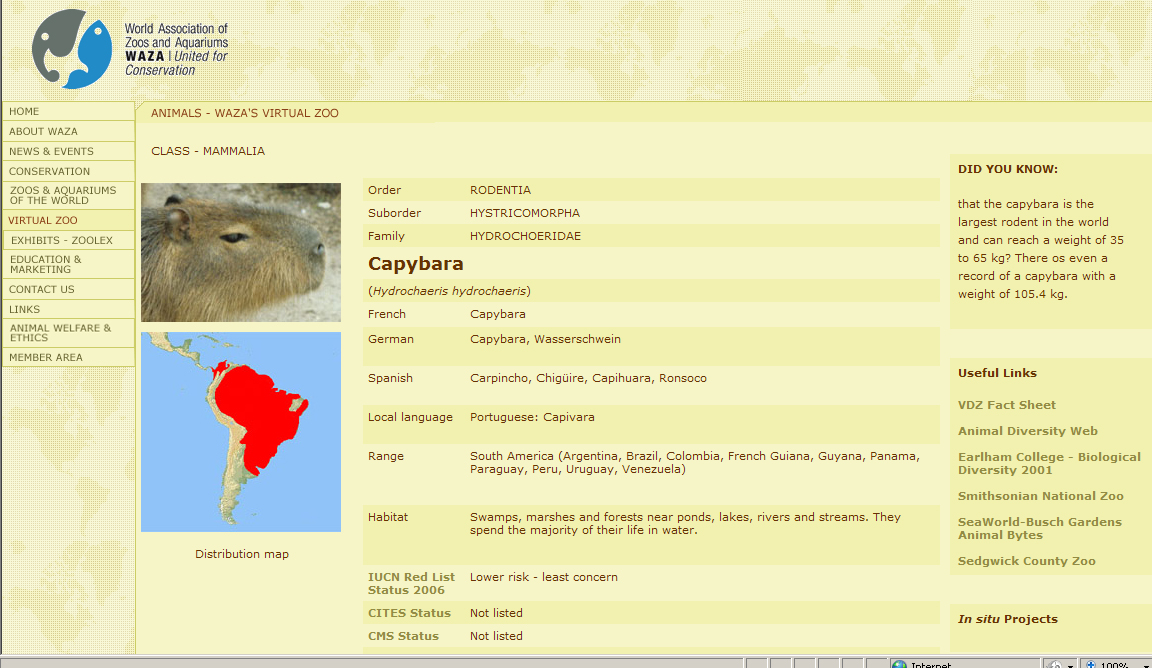
Here, you can search per species for info on exhibit sizing, husbandry, enrichment, and species behavior. This is an excellent starting point or supplement to other exhibit resources. Check it out here. I've also added the link to my Resources page.
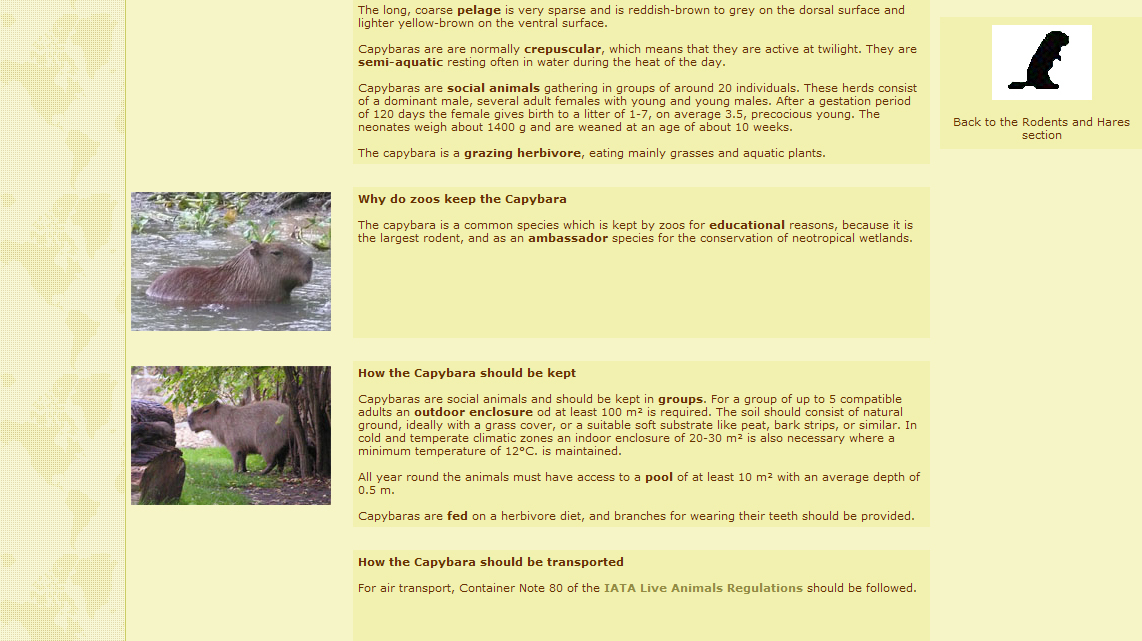
DZ's First Zoo Review: The Mote Aquarium
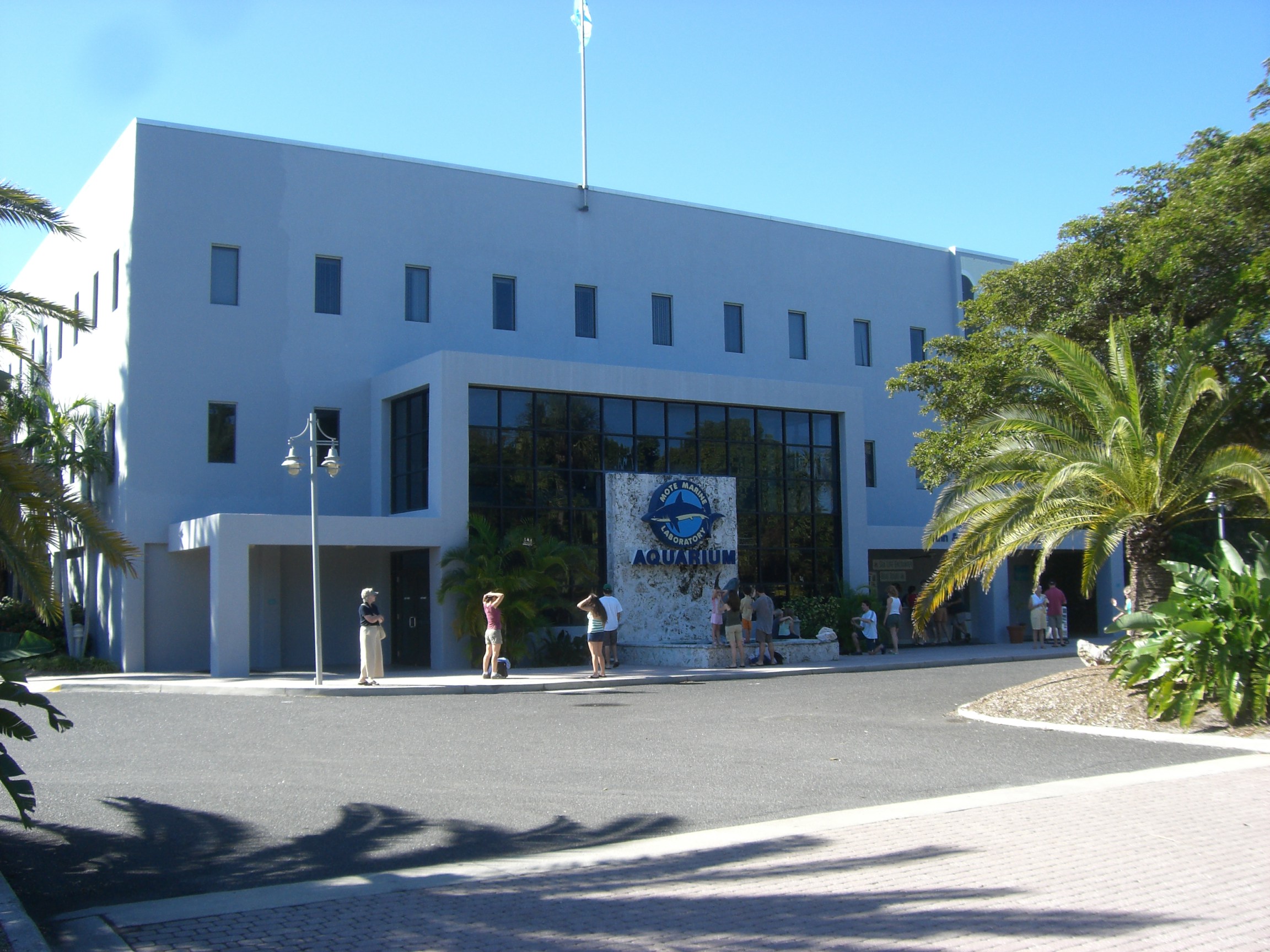
The Mote Aquarium is associated with the Mote Marine Research Laboratory, and as such has a few opportunities to view "behind the scenes". The Laboratory also allows for exhibits based on its rescue and rehab functions, showcasing rehabbed animals. Despite these unique aspects, the Aquarium is, however, simply a small, out-of-date institution.
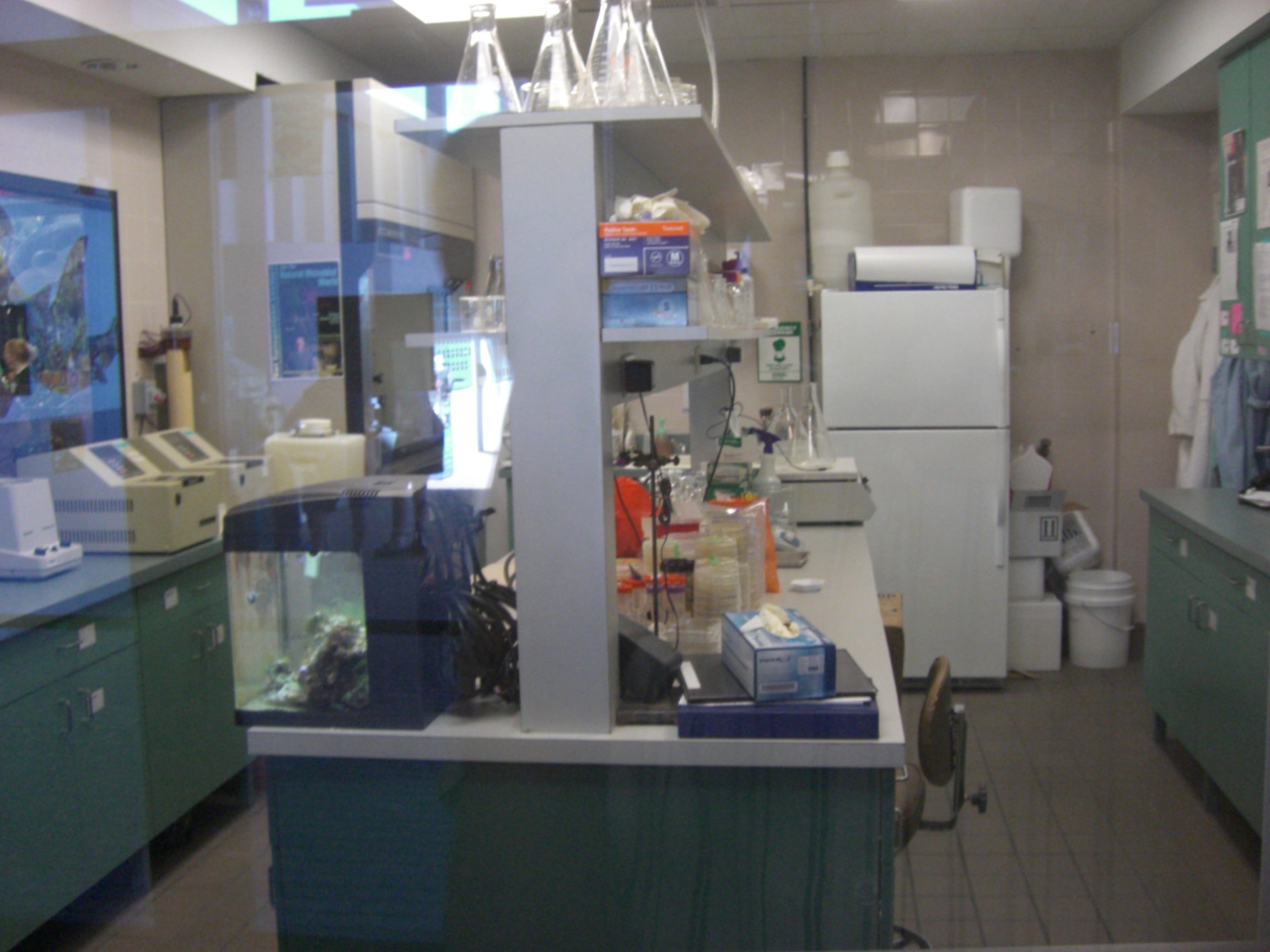
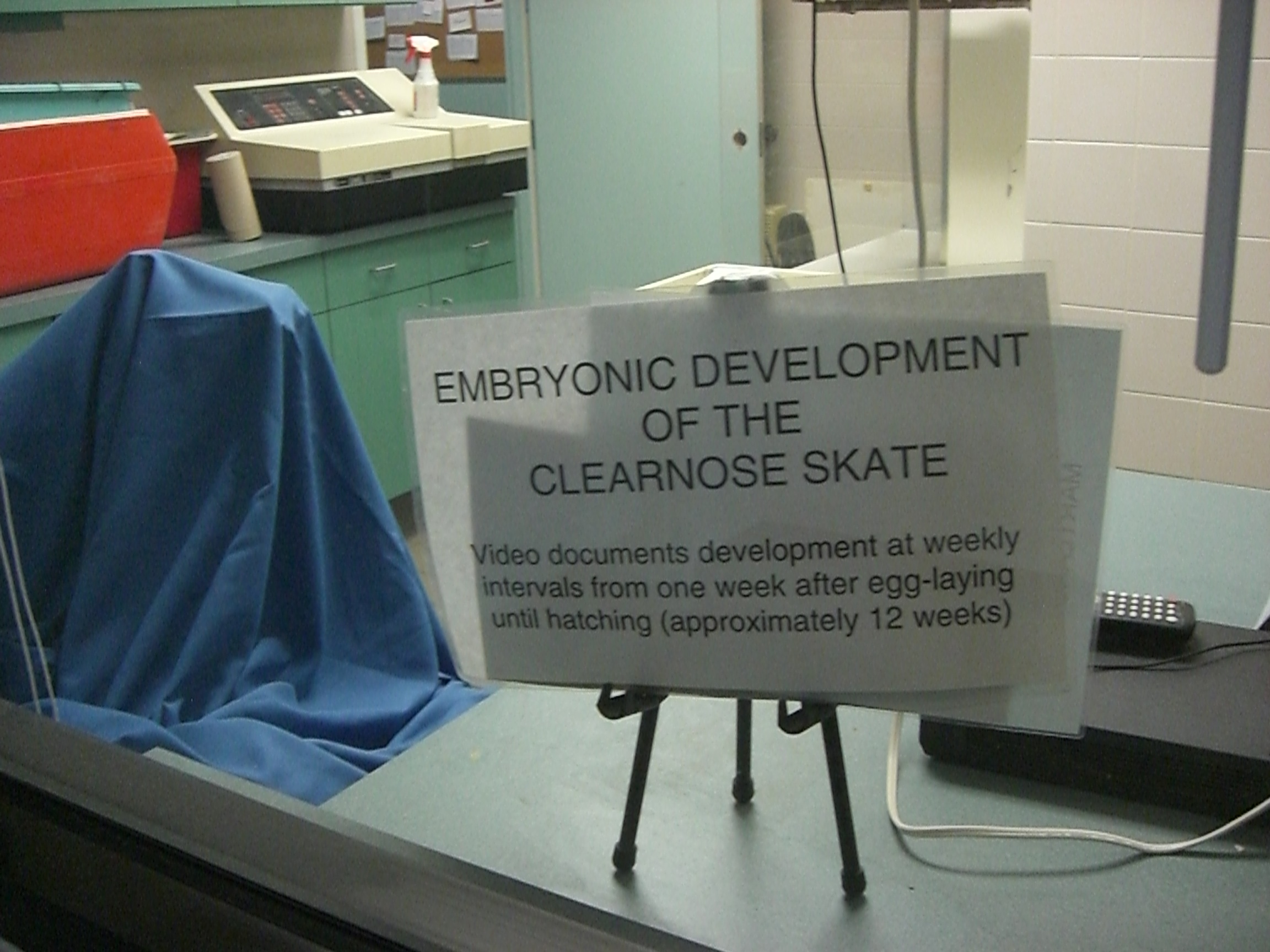
Overall, the Mote Aquarium feels incredibly sterile, with very little immersion and an amazing amount of concrete. Despite the fact that it seems reasonably clean and well maintained (exception being water quality), the Aquarium feels extremely out-of-date and generally dismal. Additionally, the Aquarium is supposedly divided into thematic or conceptual galleries, however, it is completely unclear where one area starts and another stops (except when you are lost down an endless hallway or parking lot--more on this to come).
Information, on the other hand, is overly abundant through larger than life graphic panels showing off lots of words. These panels are apparently serving as the Aquarium's theming.
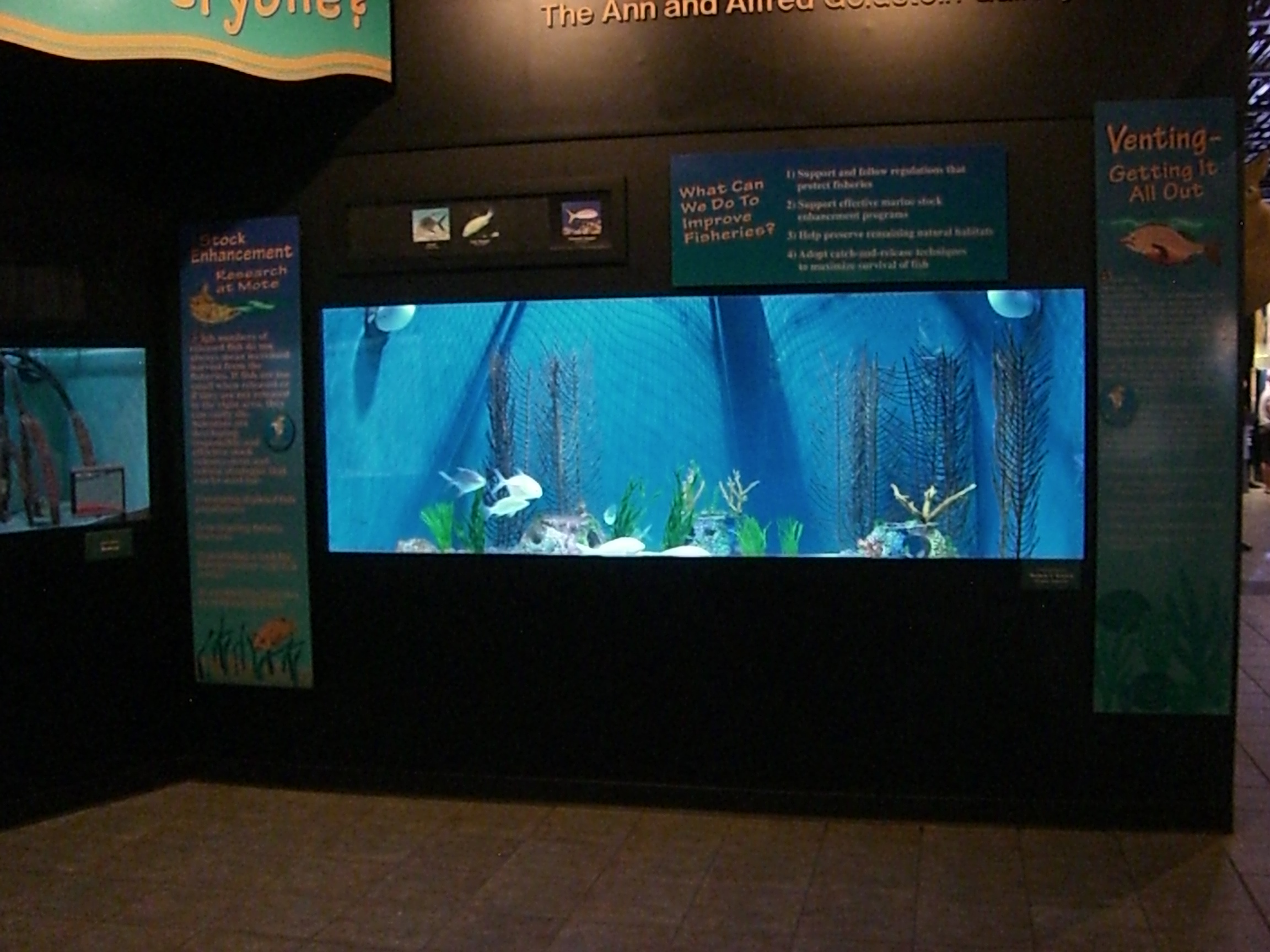

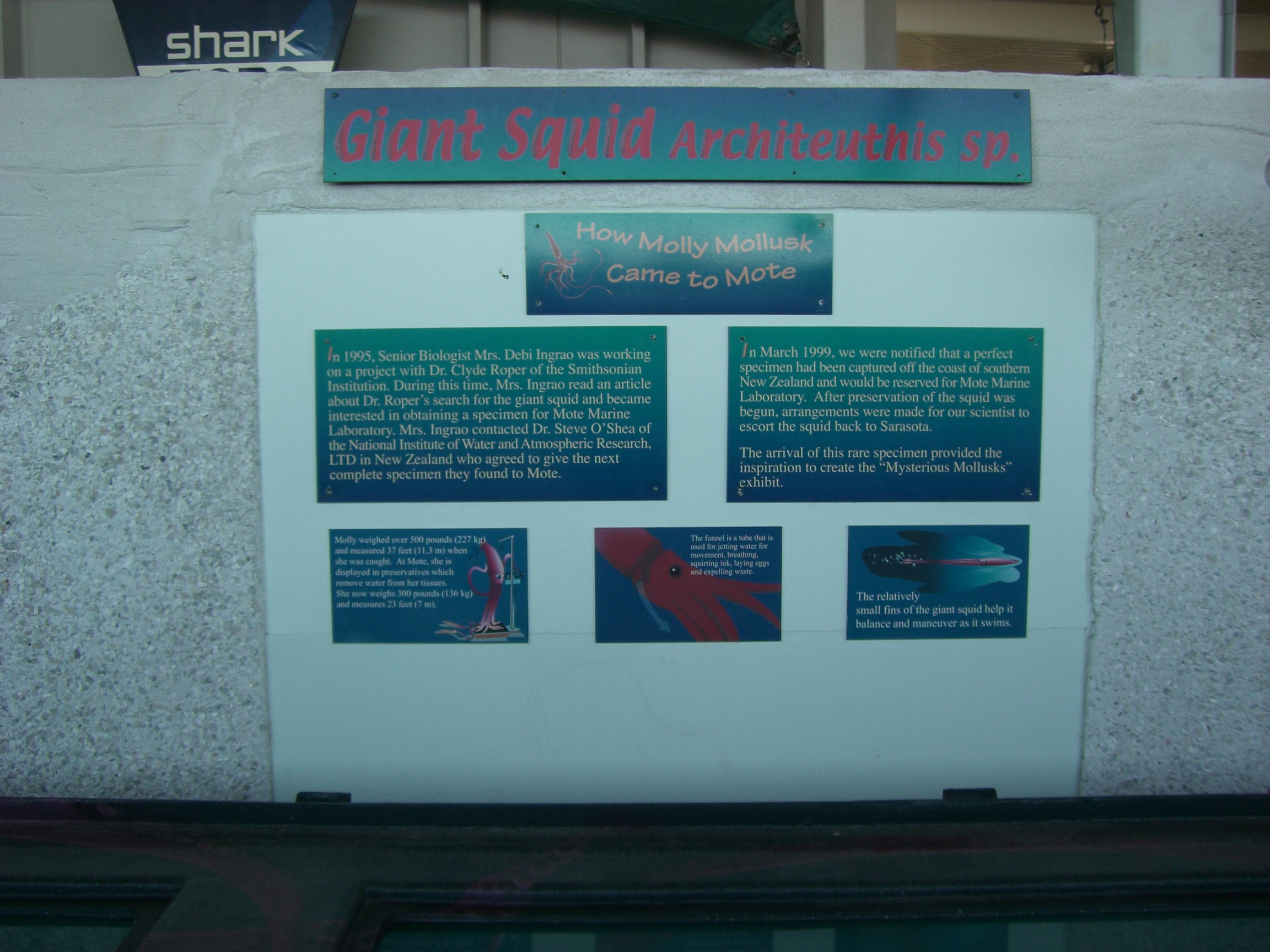
Another puzzling aspect is its division into three distinct buildings spread over a small campus. Not only is it unclear which buildings are actually associated with the Aquarium (since the parking that sits central to the campus also serves a marina and bird sanctuary), it is unclear where to even purchase tickets and begin the experience.
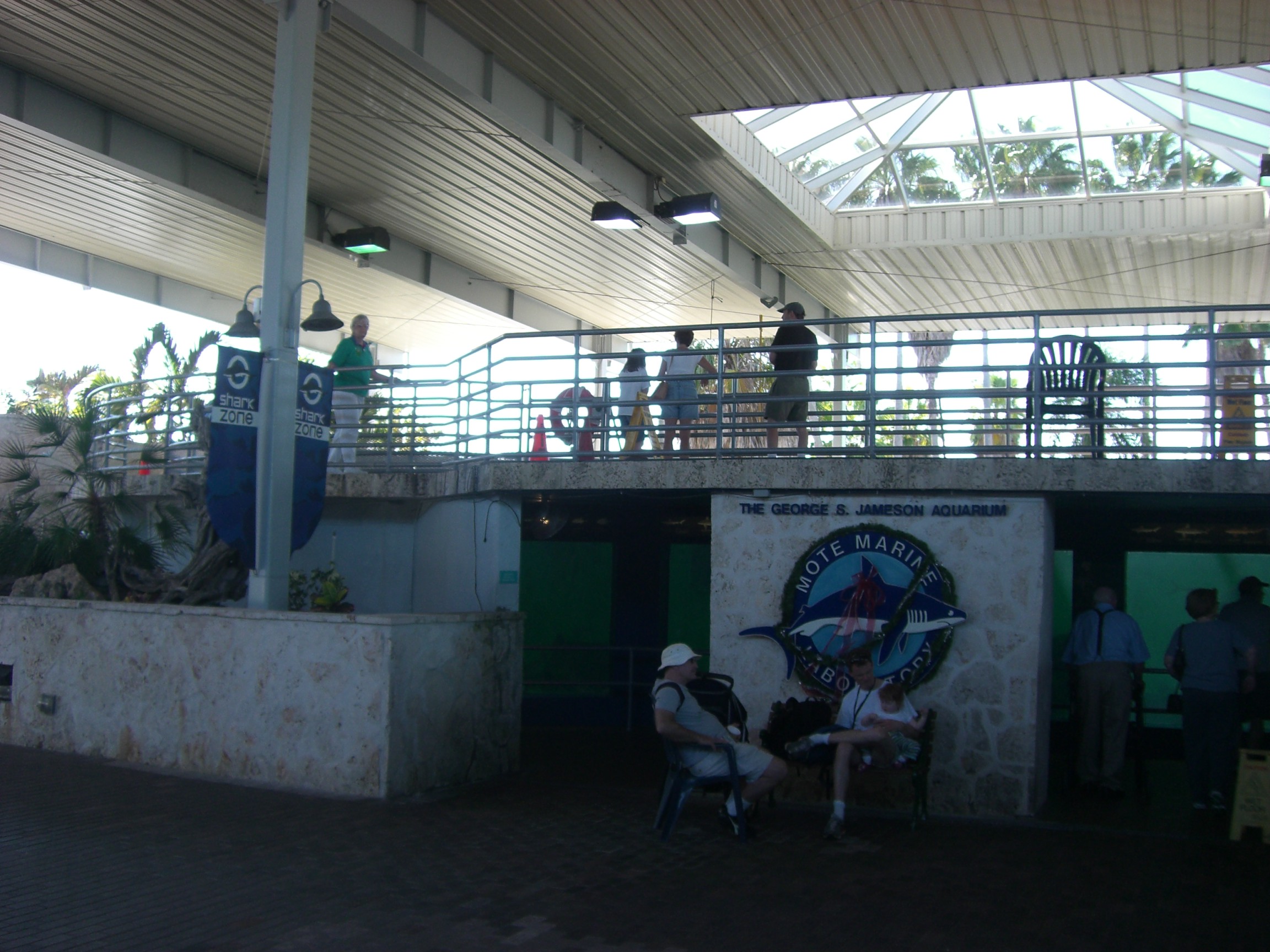
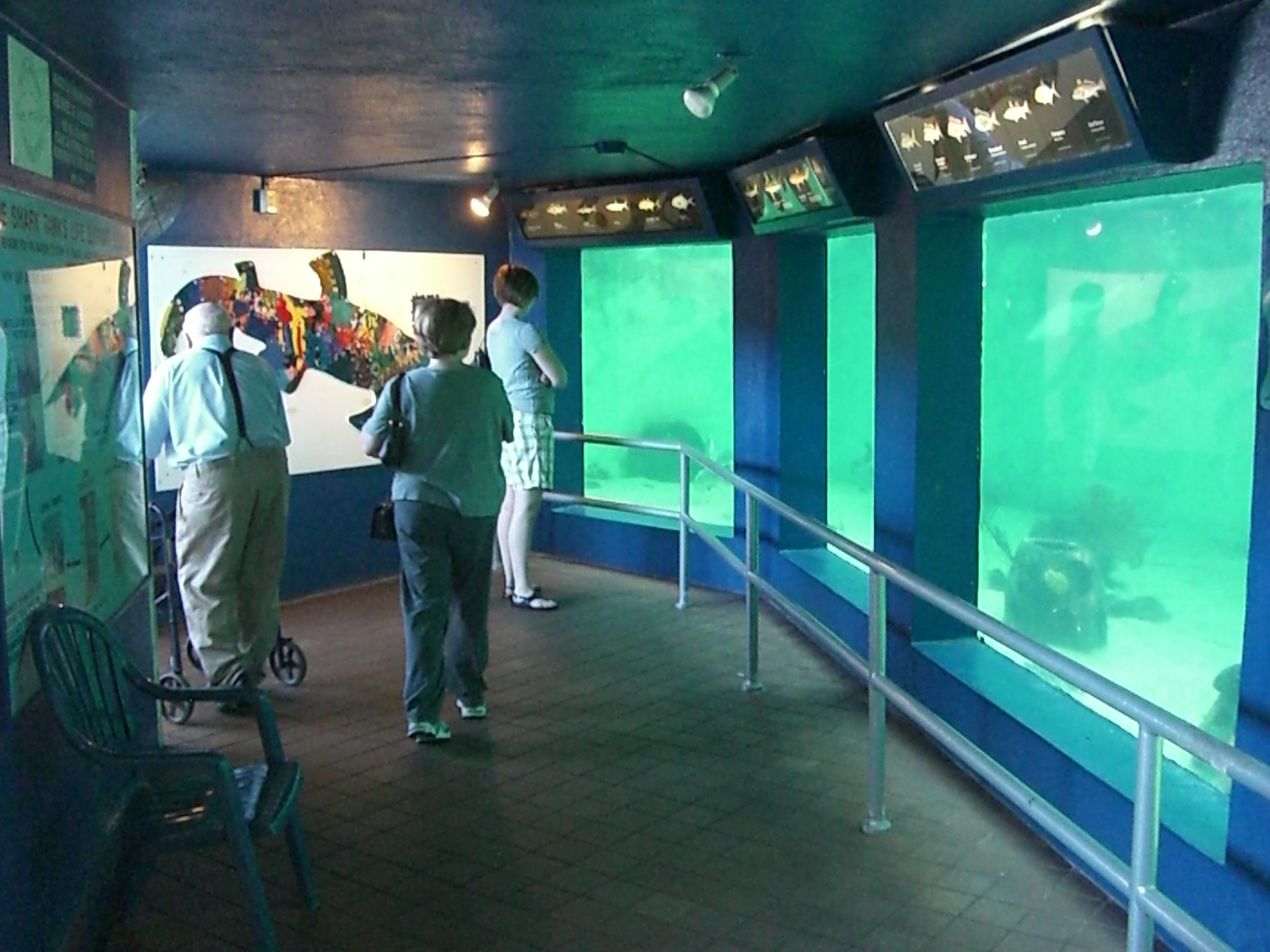
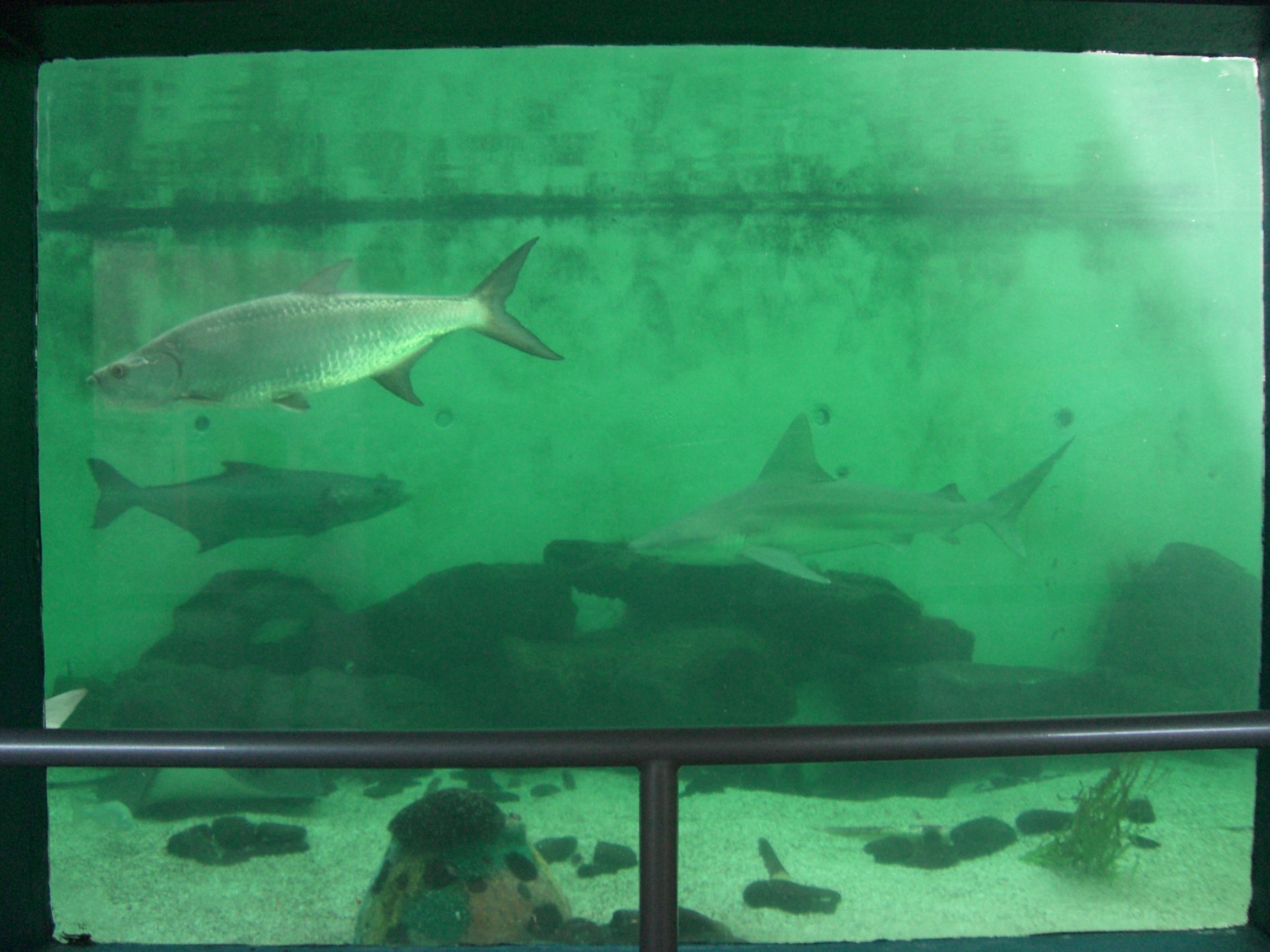
The species that should be the stand-out, hands-down star of the Aquarium, the Sharks, have two separate underwhelming tanks. I'd give the Aquarium the benefit of the doubt with the water quality in the main tank, hoping perhaps they were having an off-day, but one look into the underwater viewing shows disgusting algae and debris floating around the bottom and growing on the walls. The single underwater viewing area at this tank is horribly undersized for the amount of guests wanting to have a look and for the size of the tank. The above water viewing feels like a back-of-house area that you've accidentally stumbled upon. This covered outdoor exhibit could be very interesting with only a few changes, but as it stands currently, it is simply a sad, dirty cage.
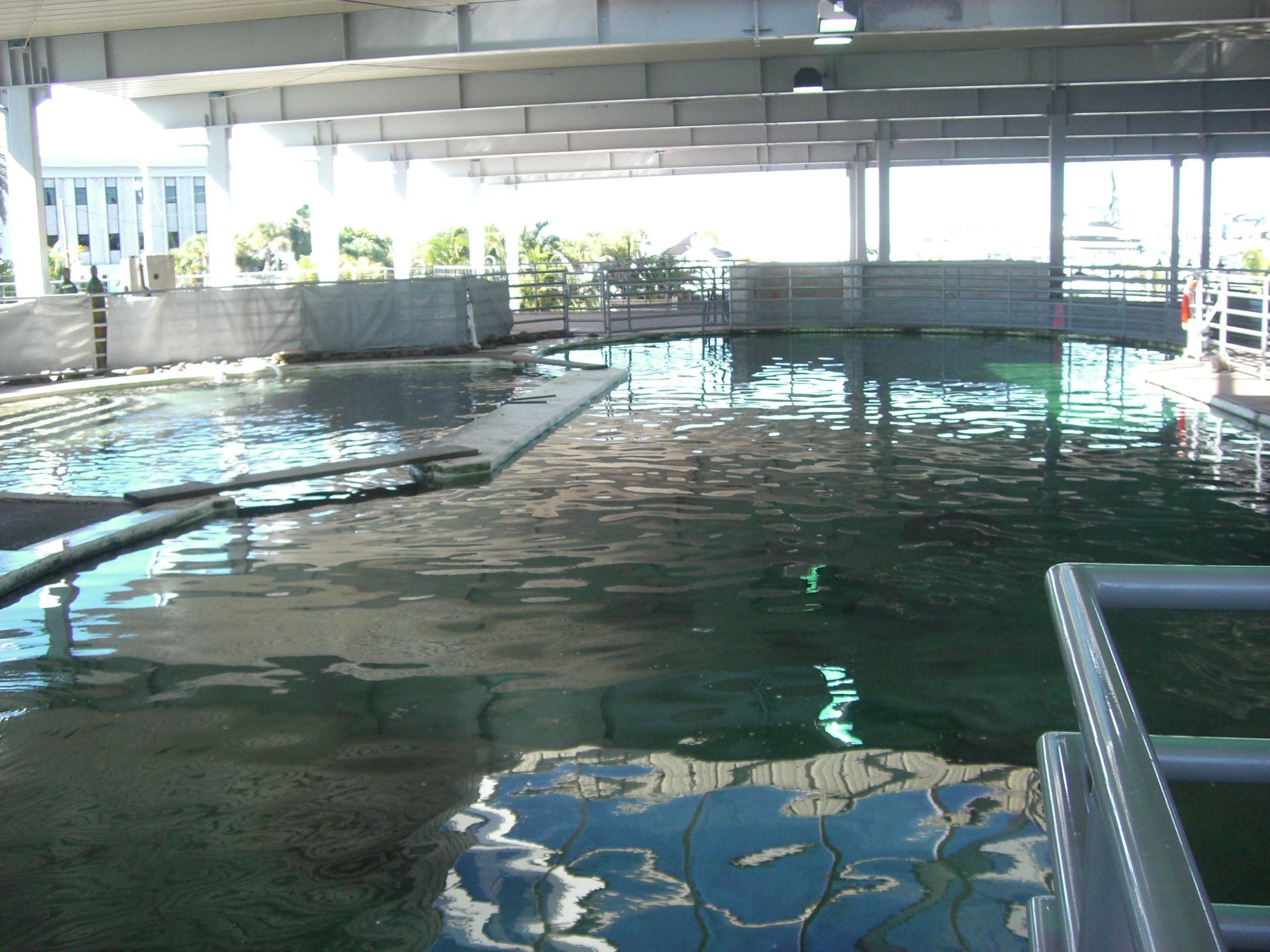
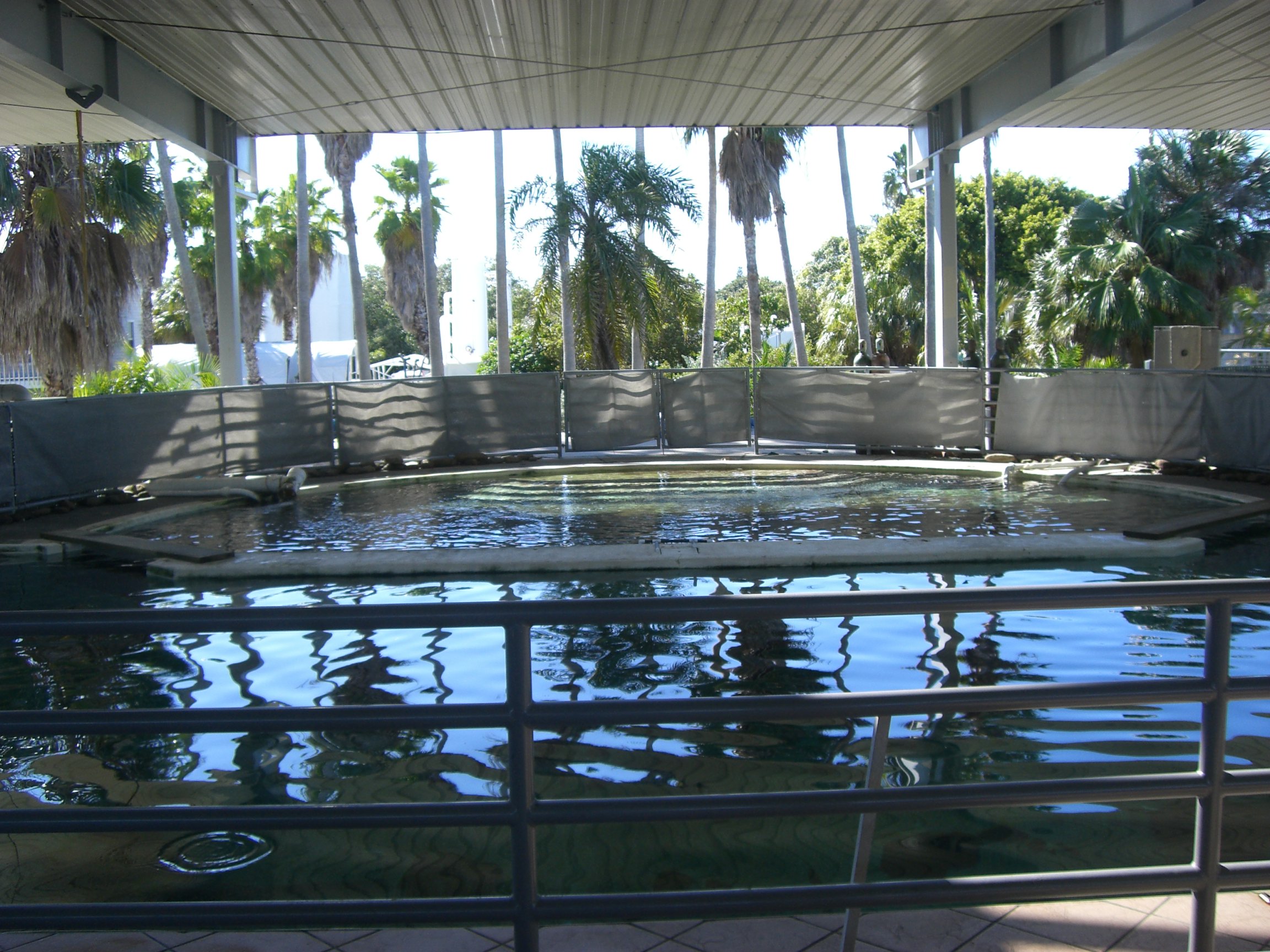
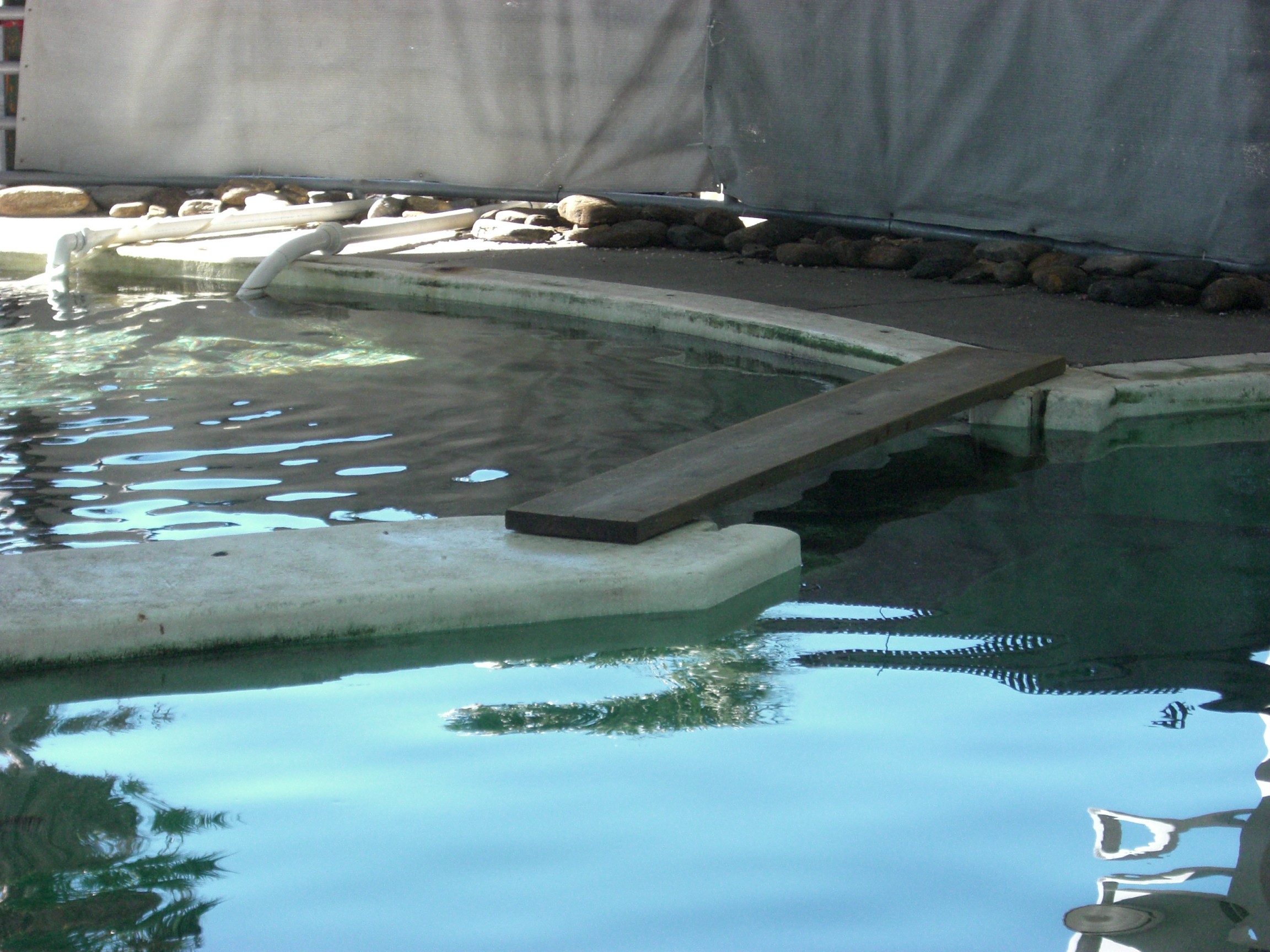
The second, much smaller shark tank has much higher water quality, and an attempt at rockwork and coral. This is completely undermined by the sad state of the coral, however, as it appears to have been rubber stamped across the tank; only one kind of artificial coral was used, and the attachment points are painfully obvious. Additionally, the lovely sandy bottom seems to have been over taken by invasive plastic marine plants.
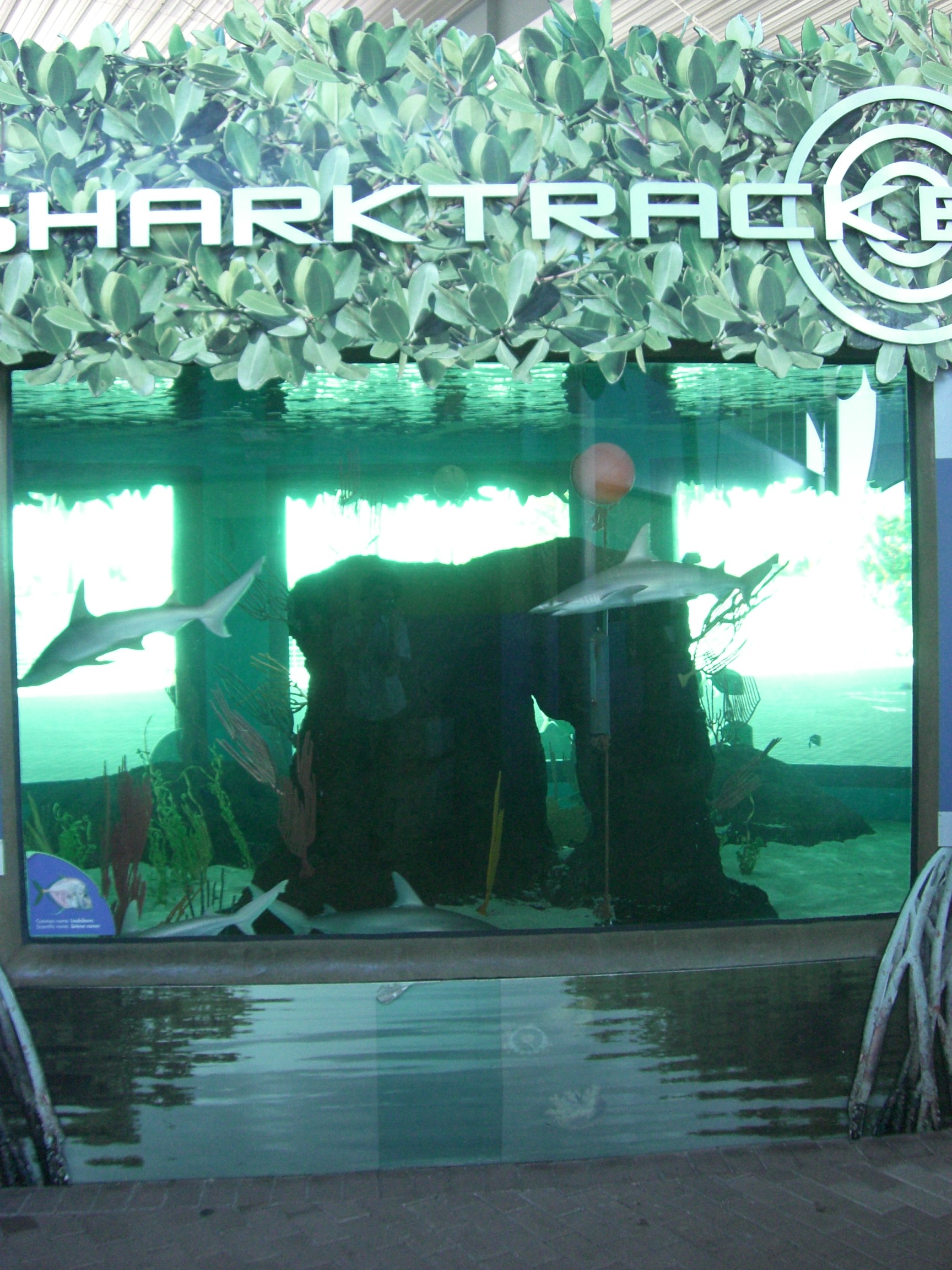
- Smaller Shark Tank
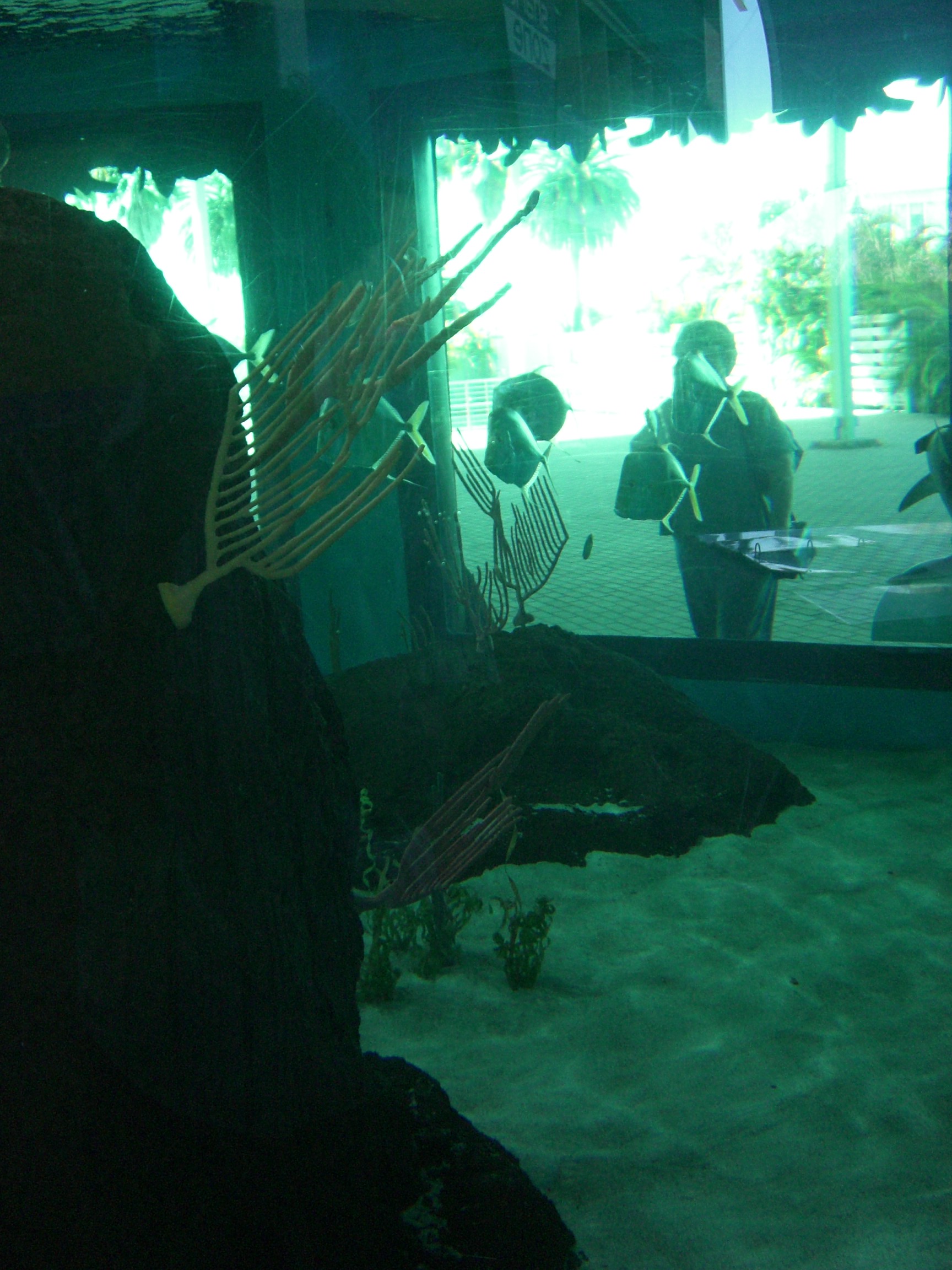
- Plastic coral and plants
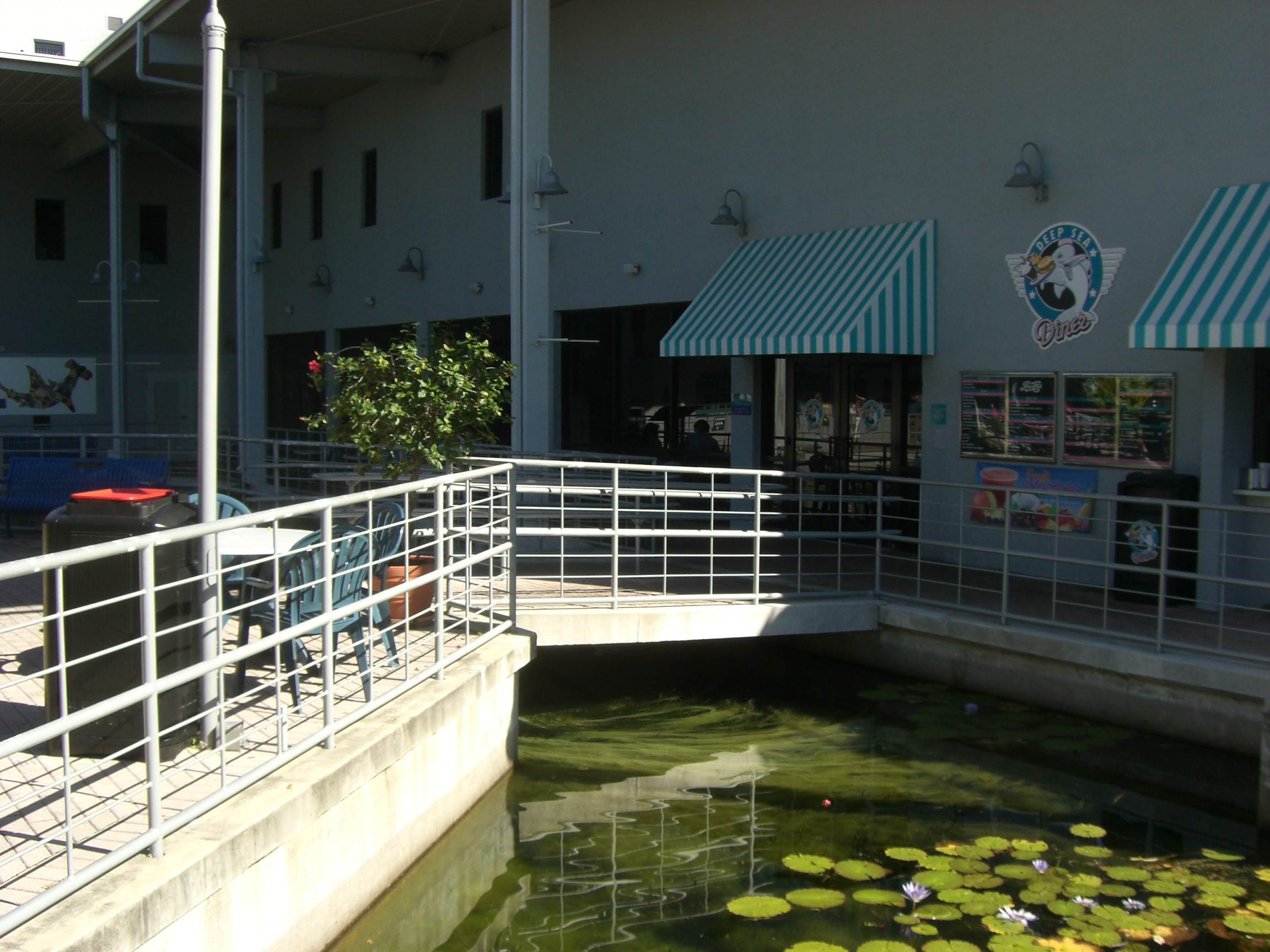
After finding our way through building one, housing the sharks and several smaller tanks, the gift shop and the kitschy 50s restaurant, we found ourselves back in the parking lot, wondering how to find the sea turtles, manatee, and dolphins. After wandering around the parking lot for a while, we finally notice sea turtles and manatees painted onto the pavement, subtly guiding us across a busy street and into another building.
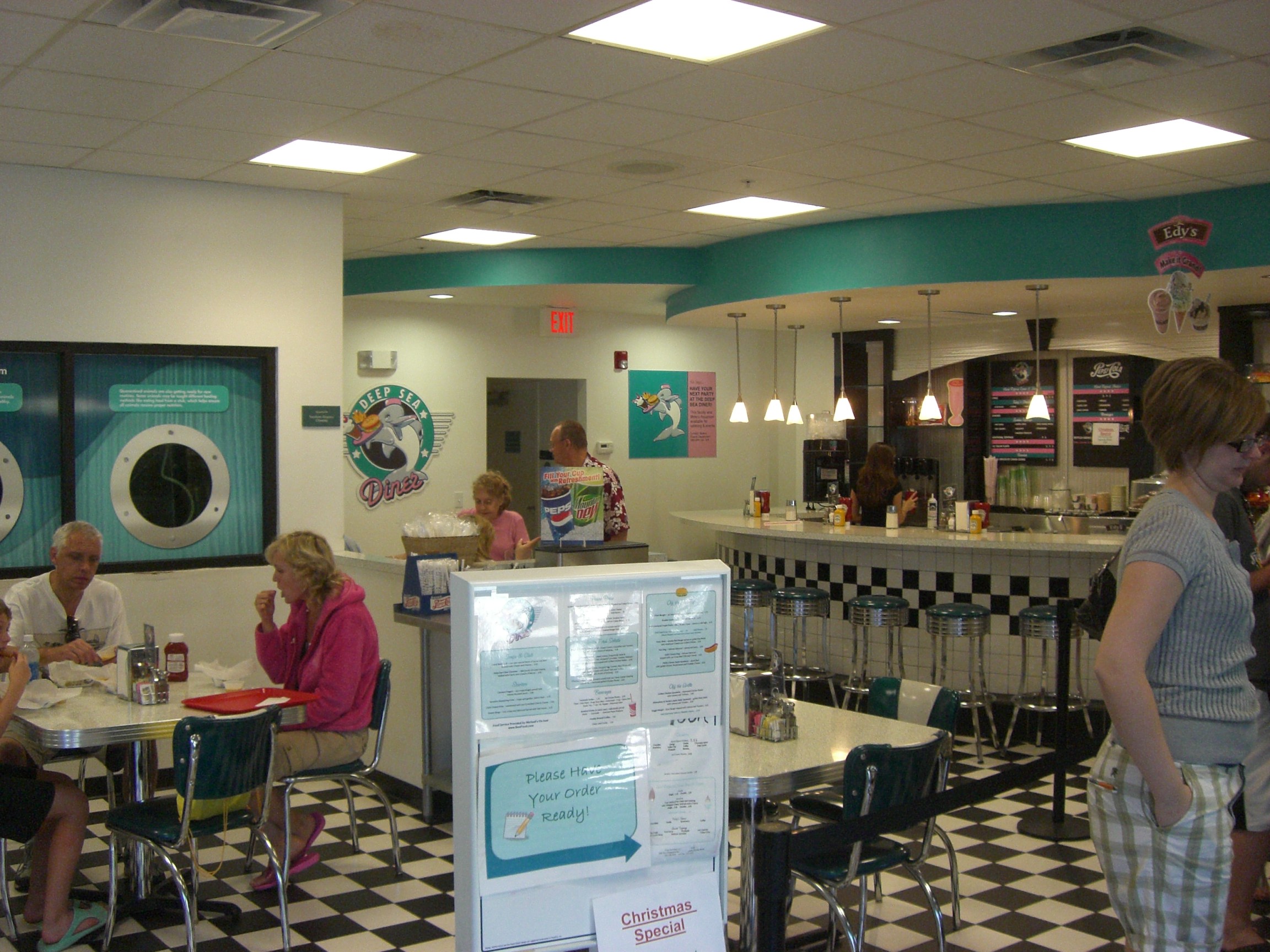

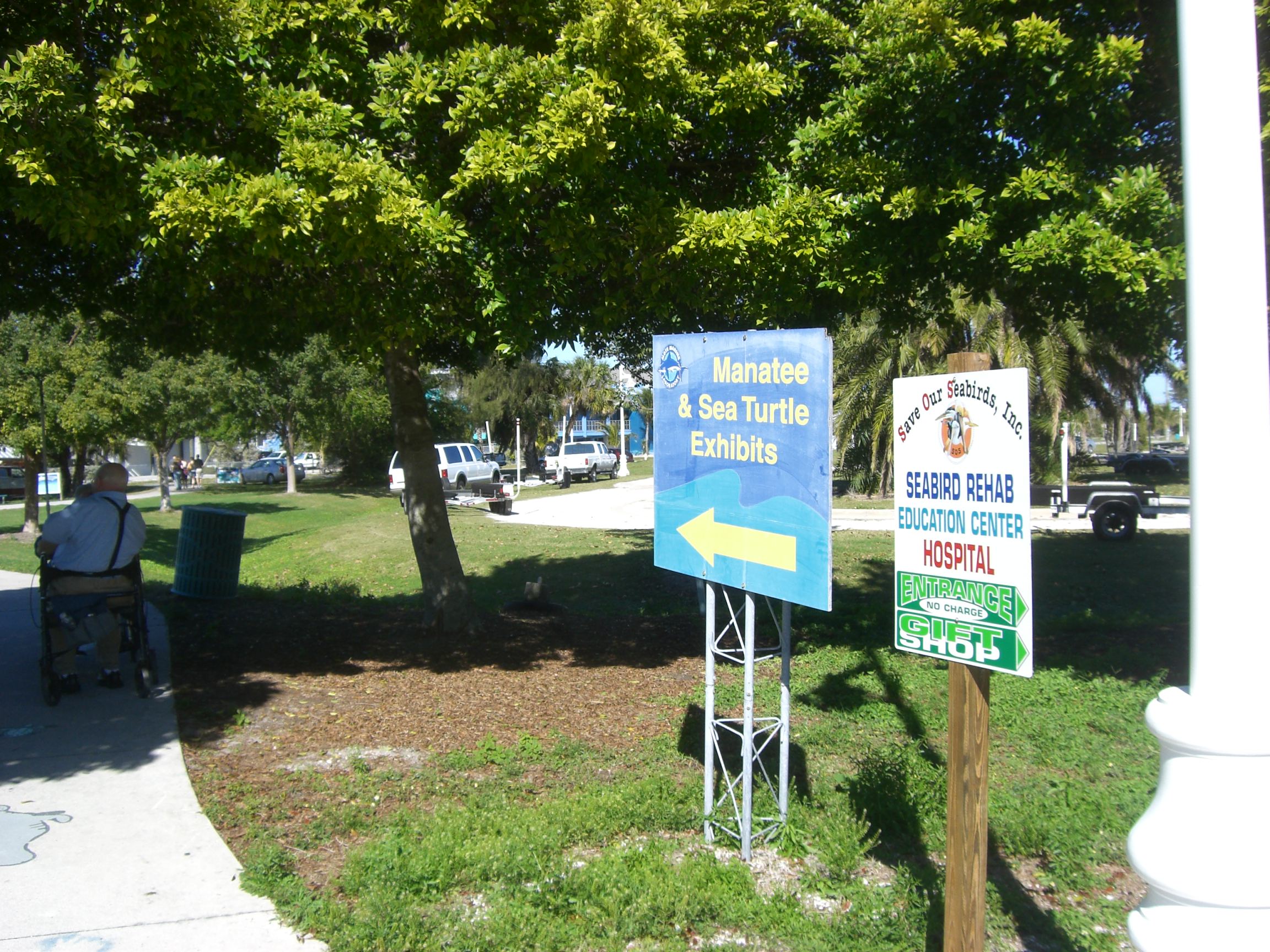
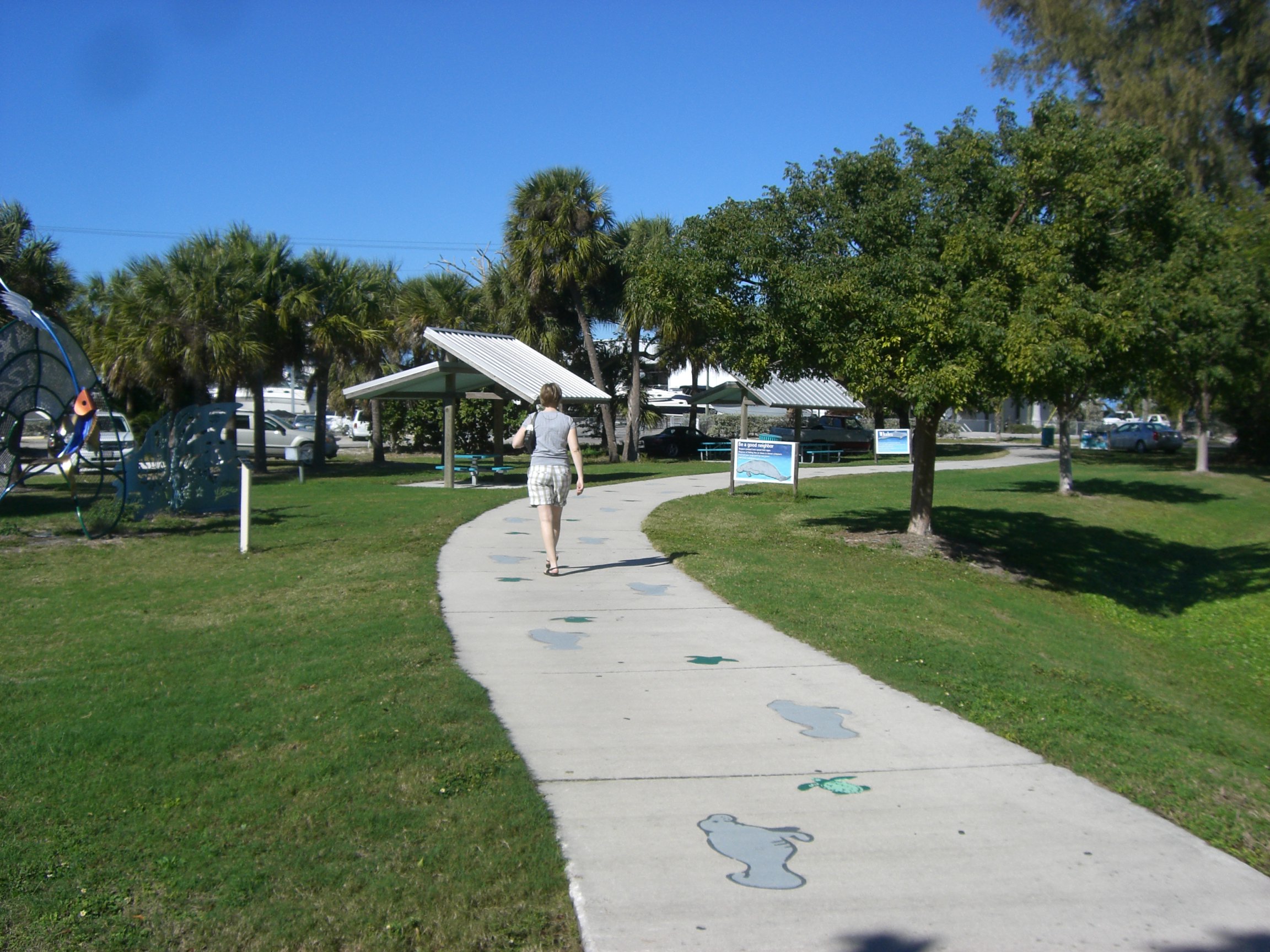
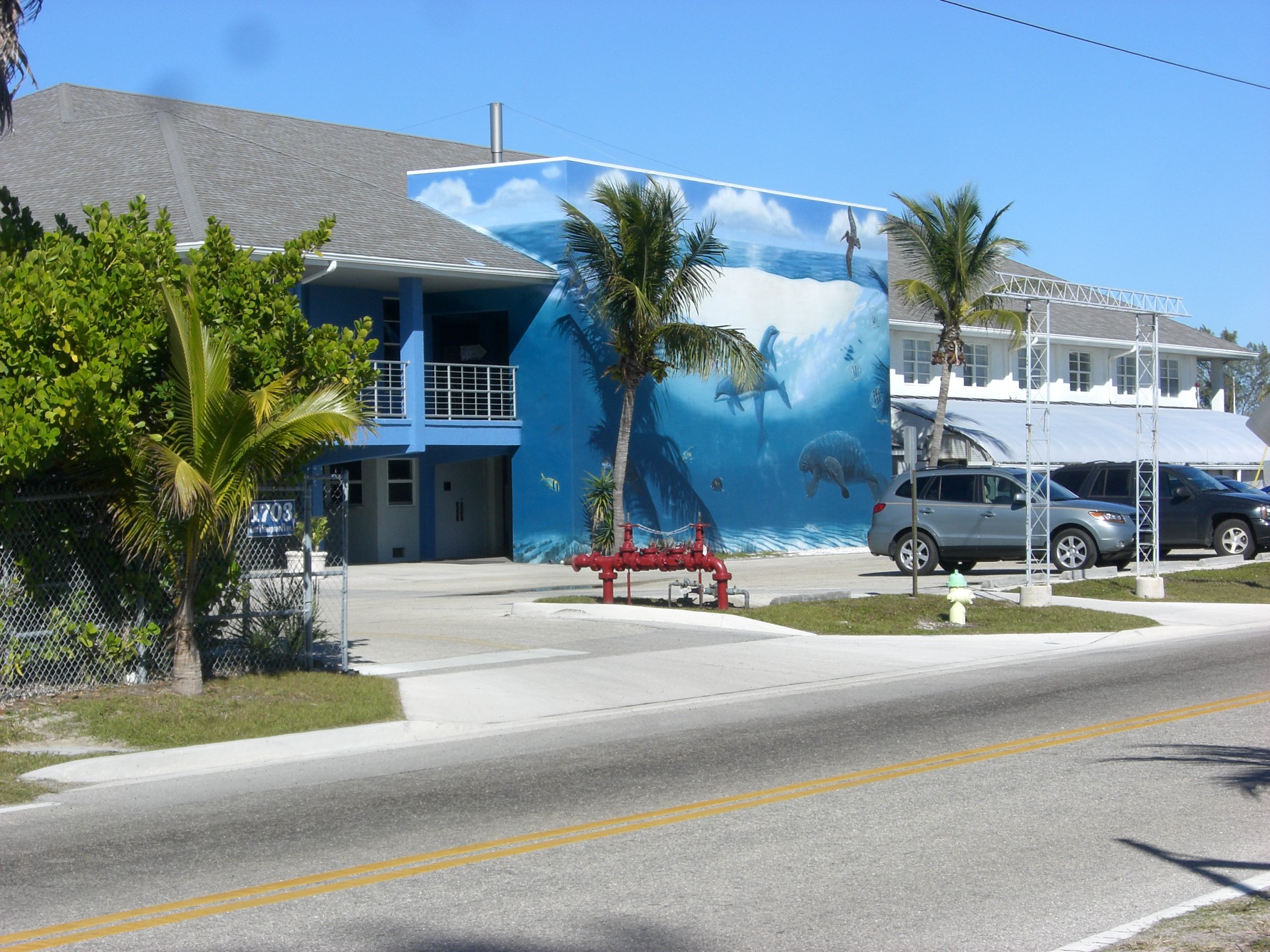
Here, we find a confusing mess of hallways and outdoor breezeways, and somehow manage to stumble upon the last few minutes of the dolphin show. This show is an informal educational demonstration, but attracts hundreds of people, crammed around the metal railing of the rectangular pool.
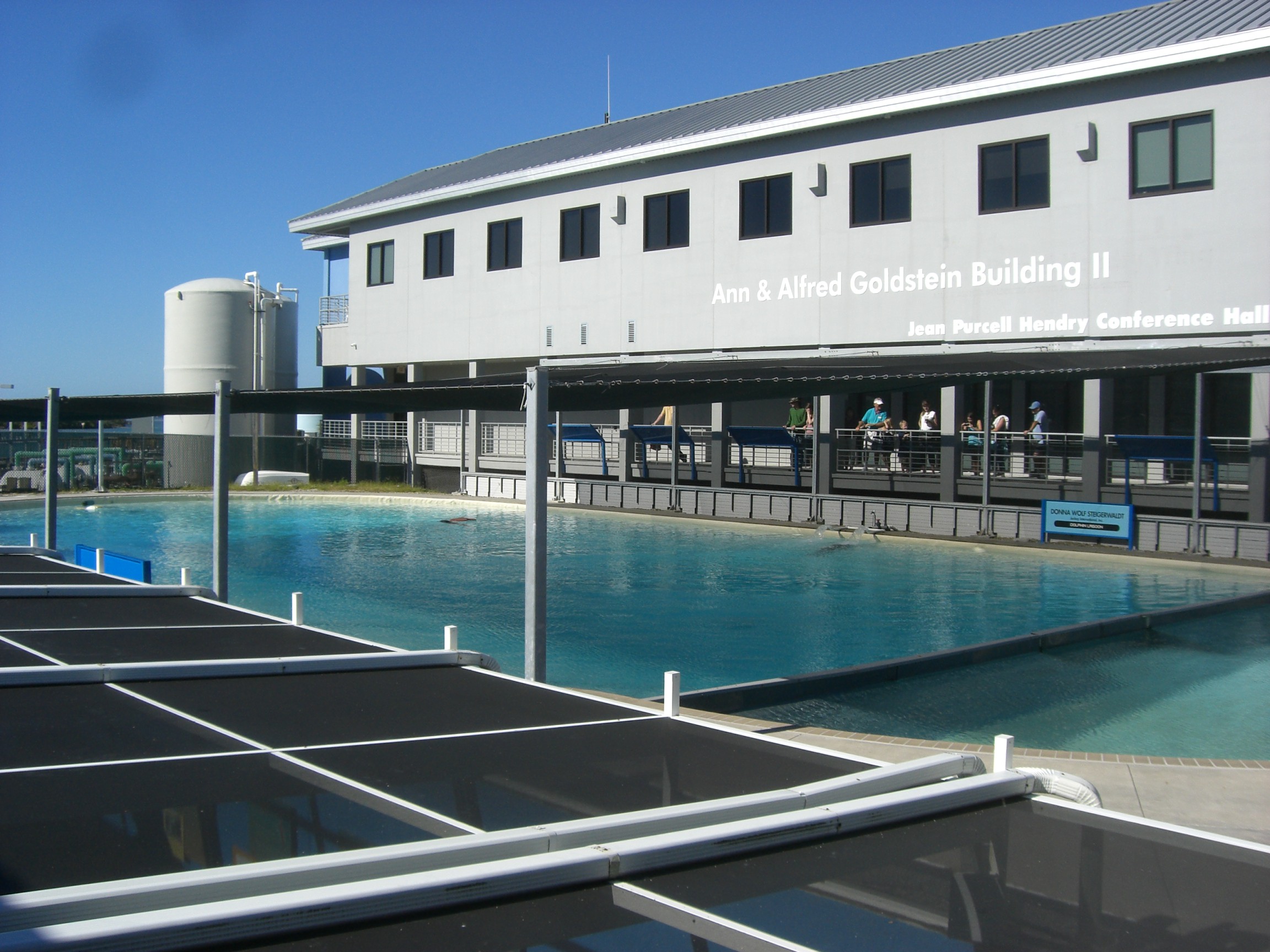
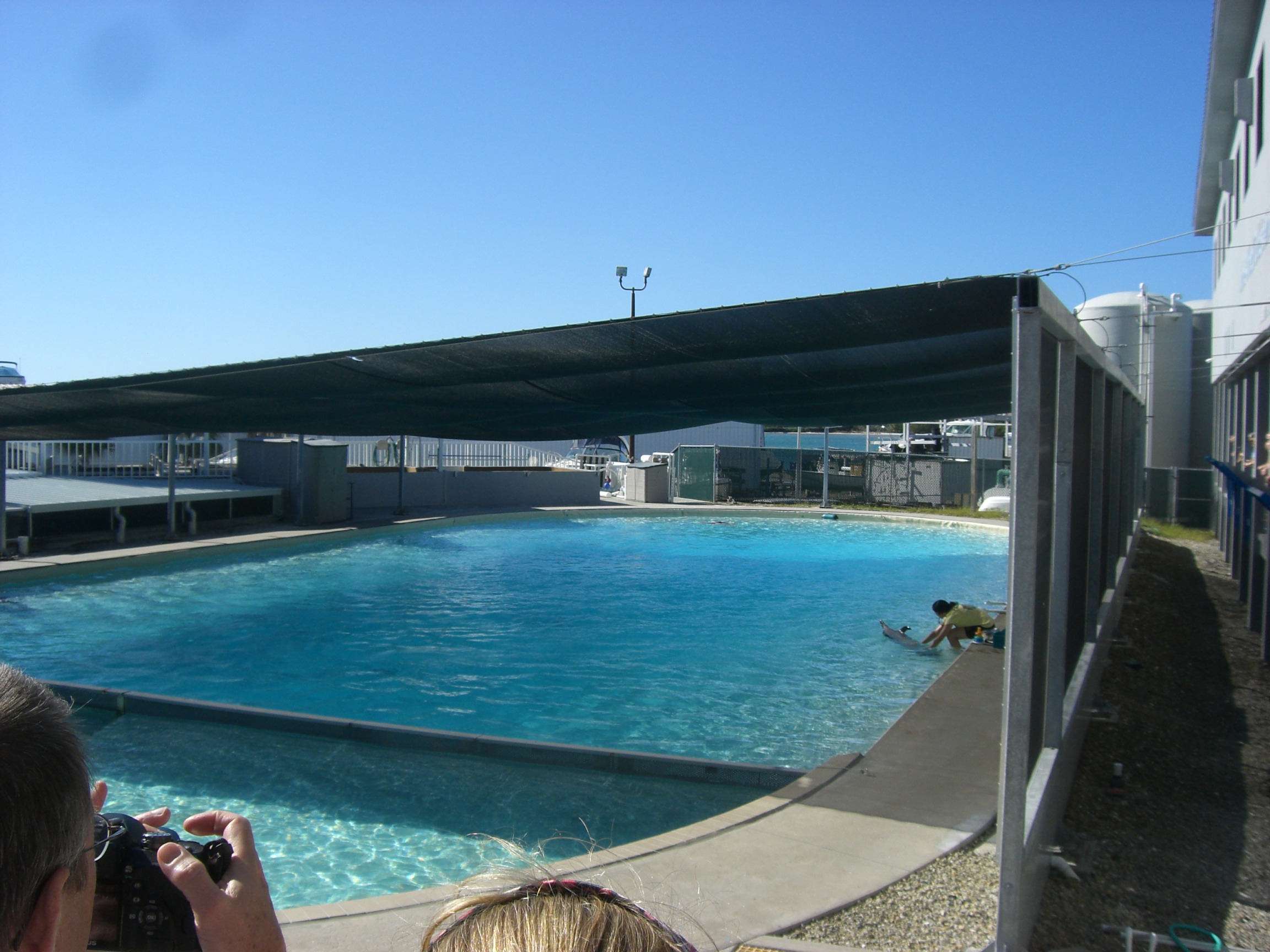
From what we saw, the dolphins demonstrate simple behaviors as an illustration of the training techniques used by the Aquarium. After the show, we walked aimlessly around trying find an actual exhibit for the dolphins, or at least an underwater viewing panel. Unfortunately, none was to be found.
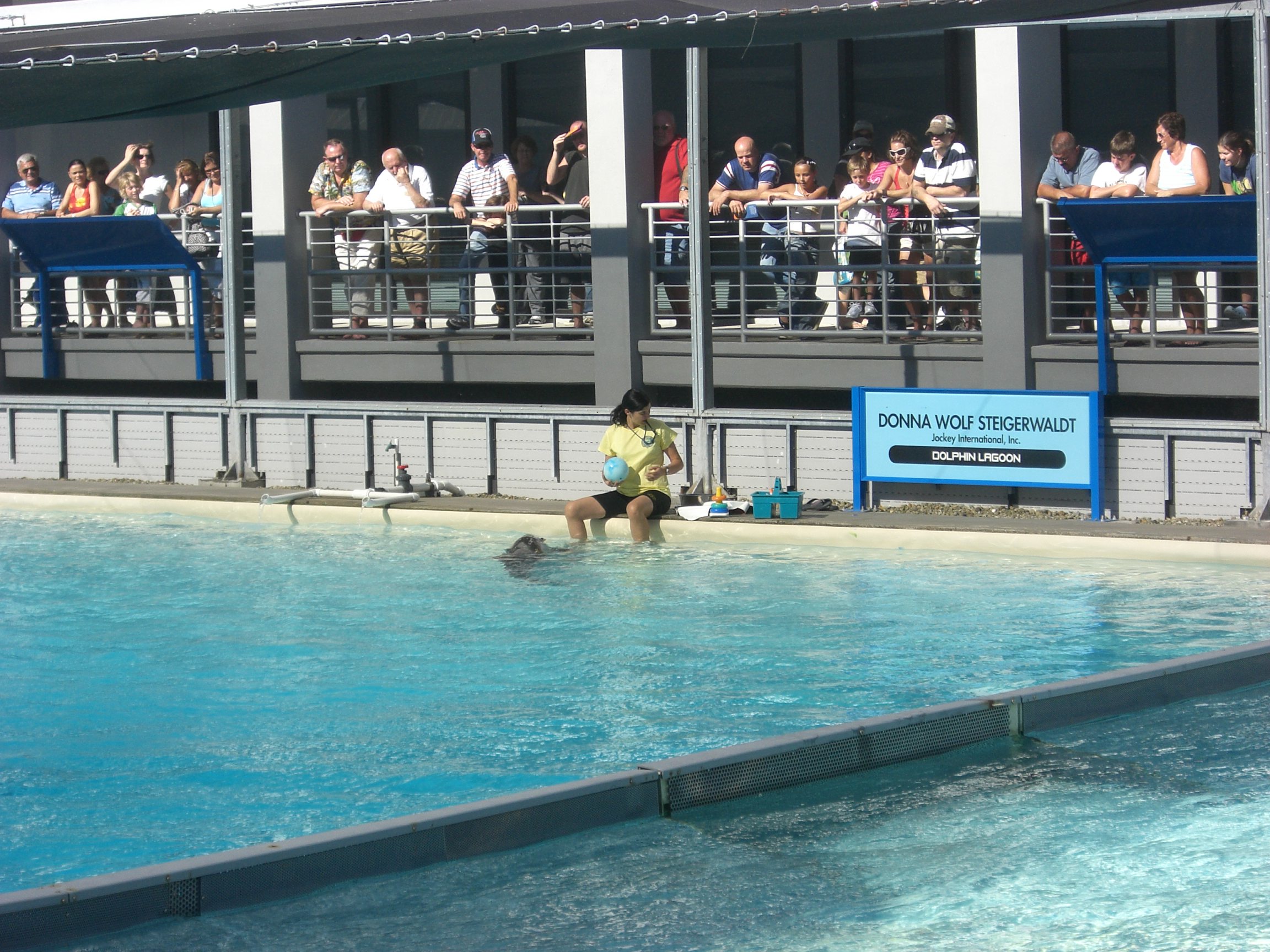
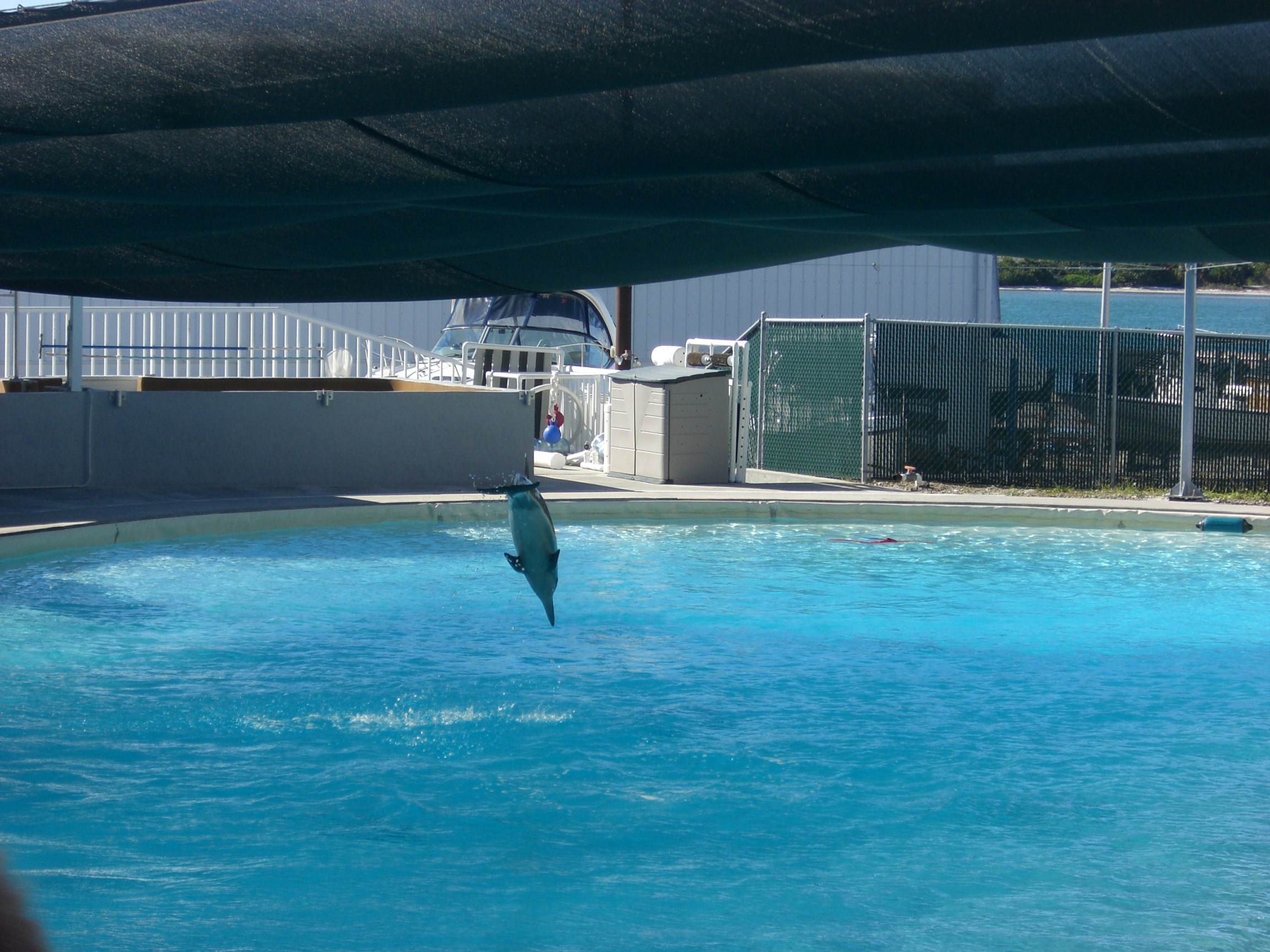
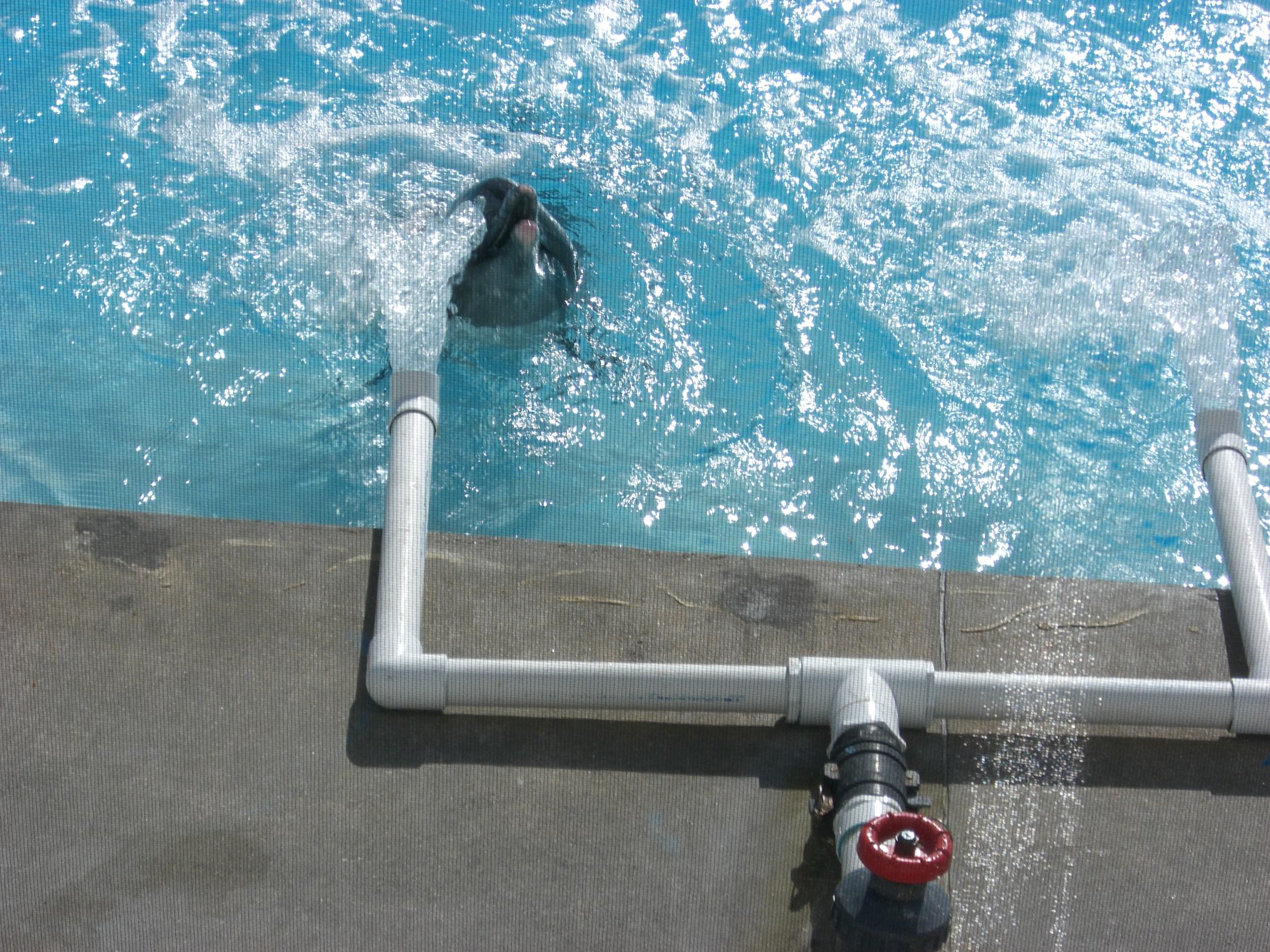
This building also houses the sea turtle rehab tanks which are about as exciting as they sound. Several elevated concrete tanks are squeezed into a small room, carefully watched over by several docents. A friendly sign across the room indicated the sea turtles are getting a new home, however, as a new sea turtle exhibit is currently being built. I'd like to get back to see that, as it seems it will be the only new exhibit built at this Aquarium in years.
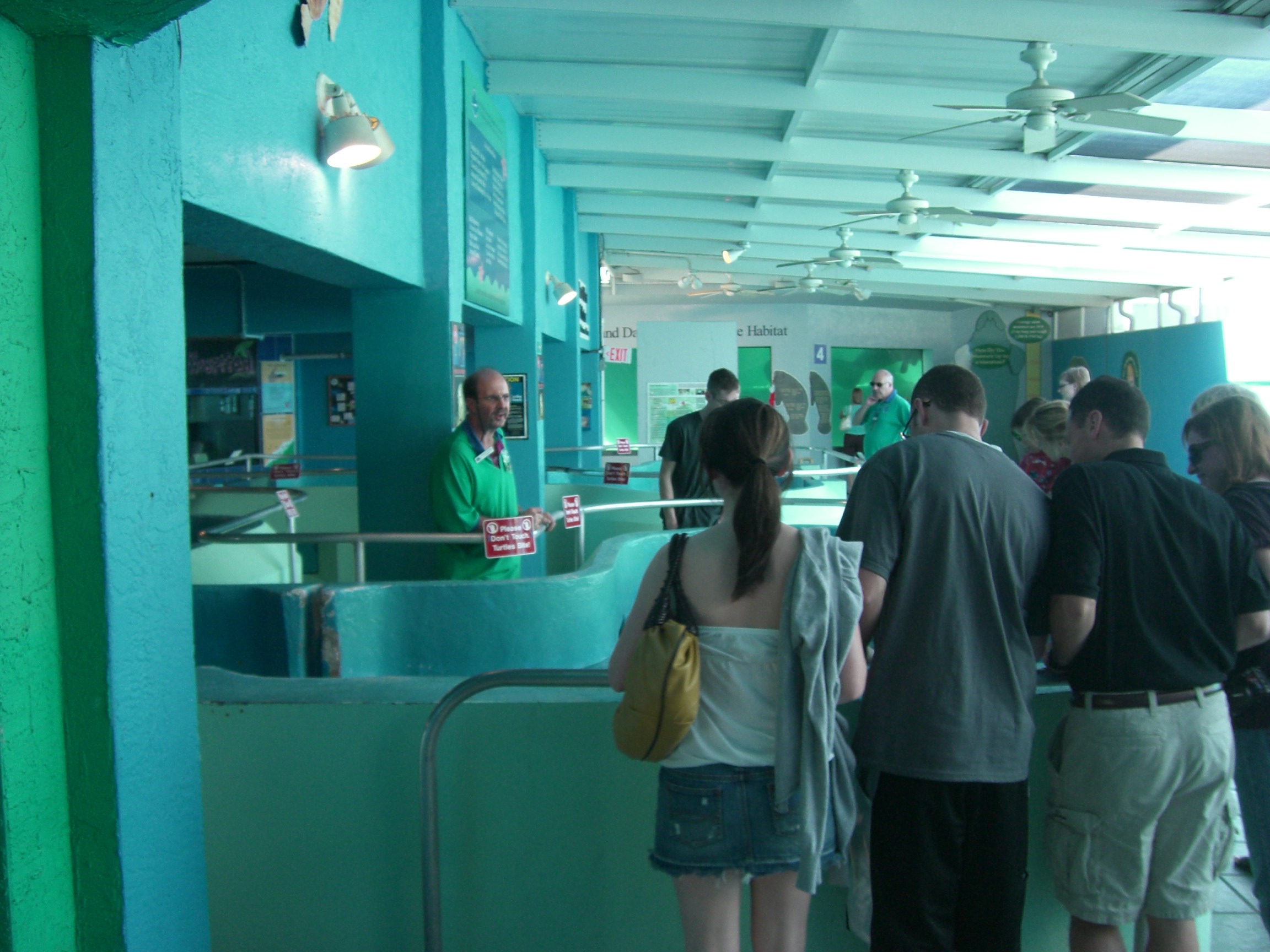
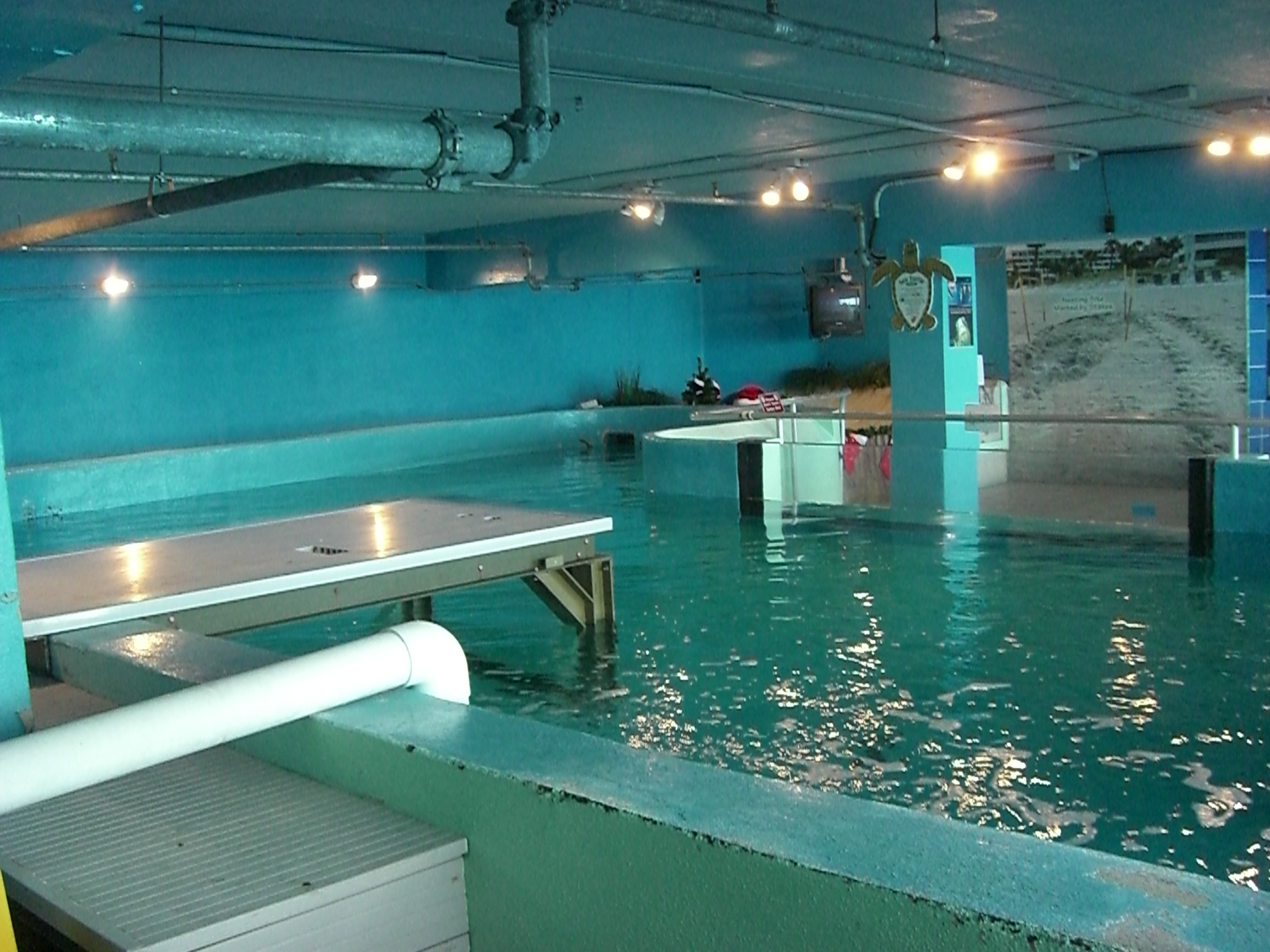
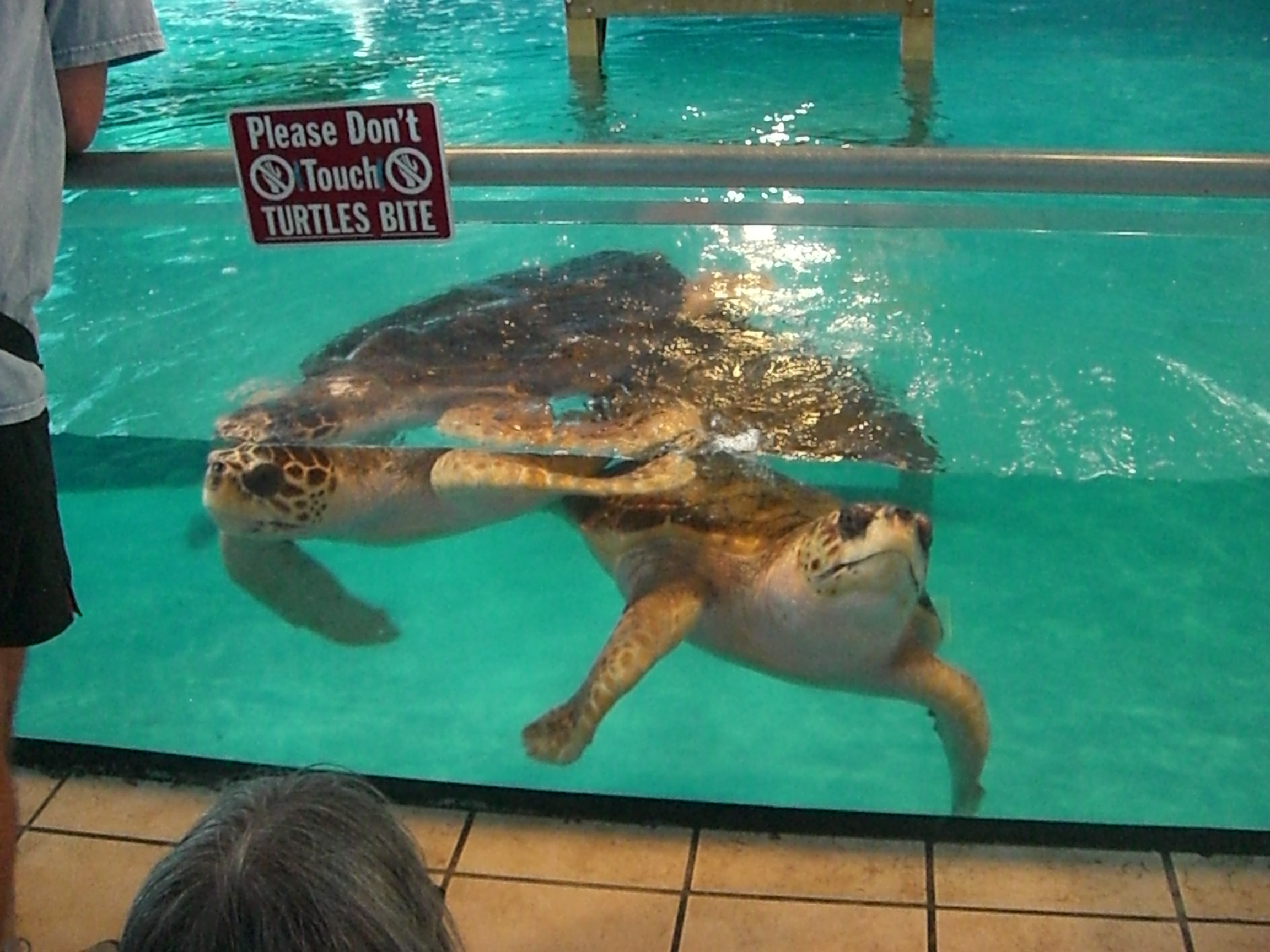
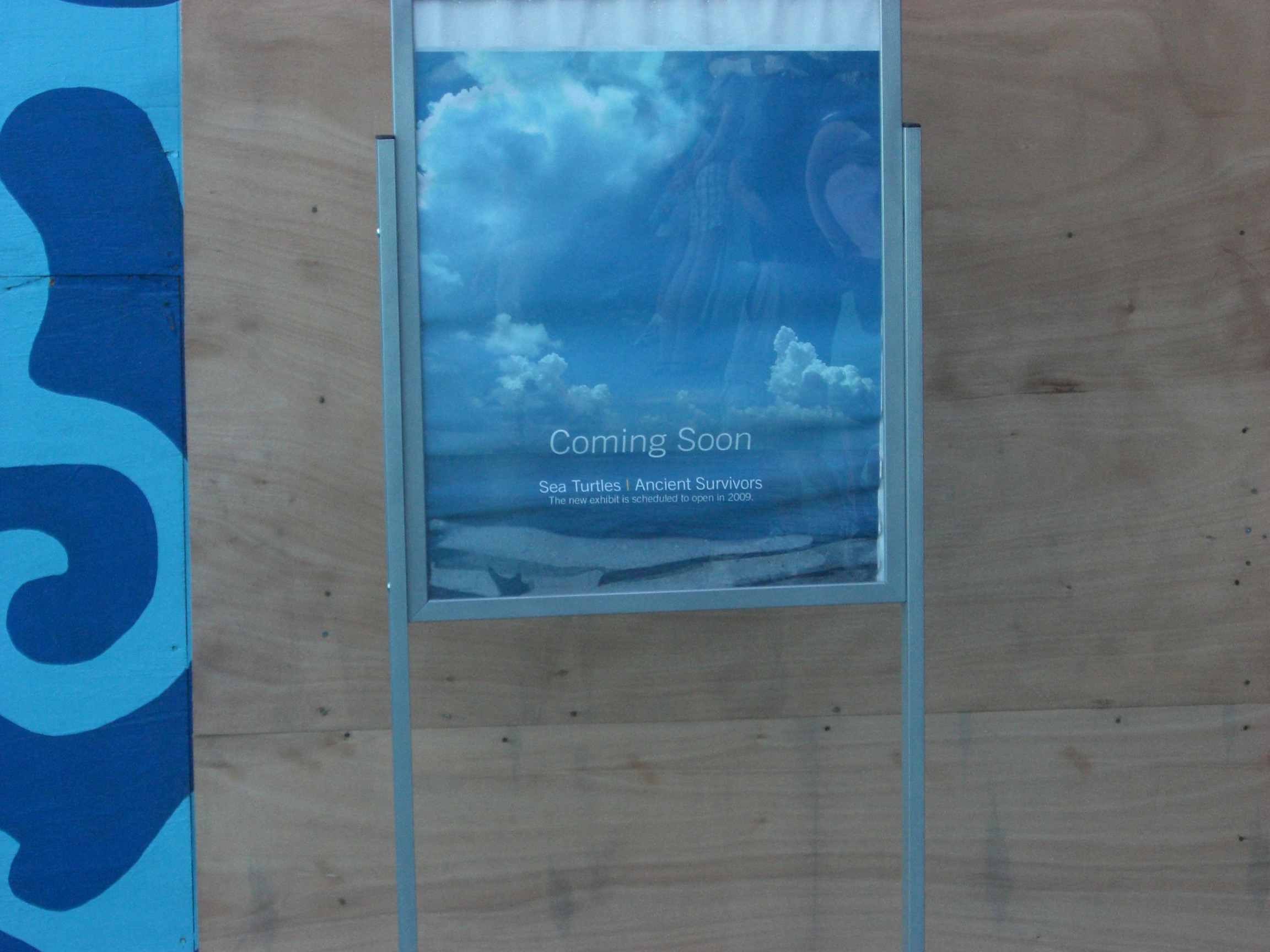
Finally, the manatees. In true Mote form, the manatee exhibit is a concrete box. This does not offend me as much as the water quality in the box. The water was so murky the manatee itself bumped into the window once or twice as we stood there. Although it appeared an additional pool, perhaps a holding or med pool, was adjacent and available to the manatees, the exhibit pool was very small for two critters. Three large windows allowed plenty of viewing, but the glare from the surrounding exterior windows, with some help from the milky water, made it nearly impossible to enjoy. Add the tiny pool, and the overall experience was rather depressing.
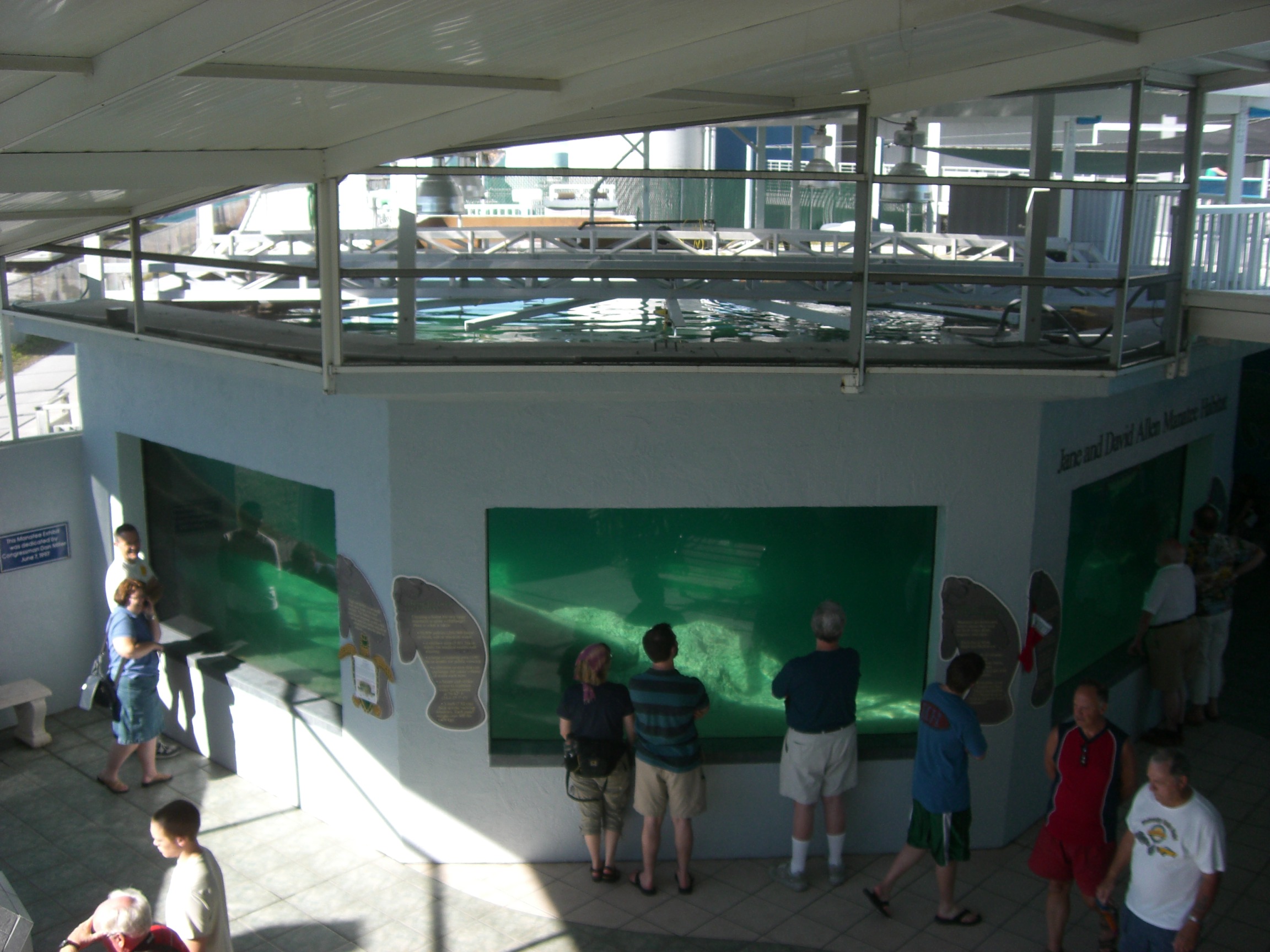
- Manatee Exhibit
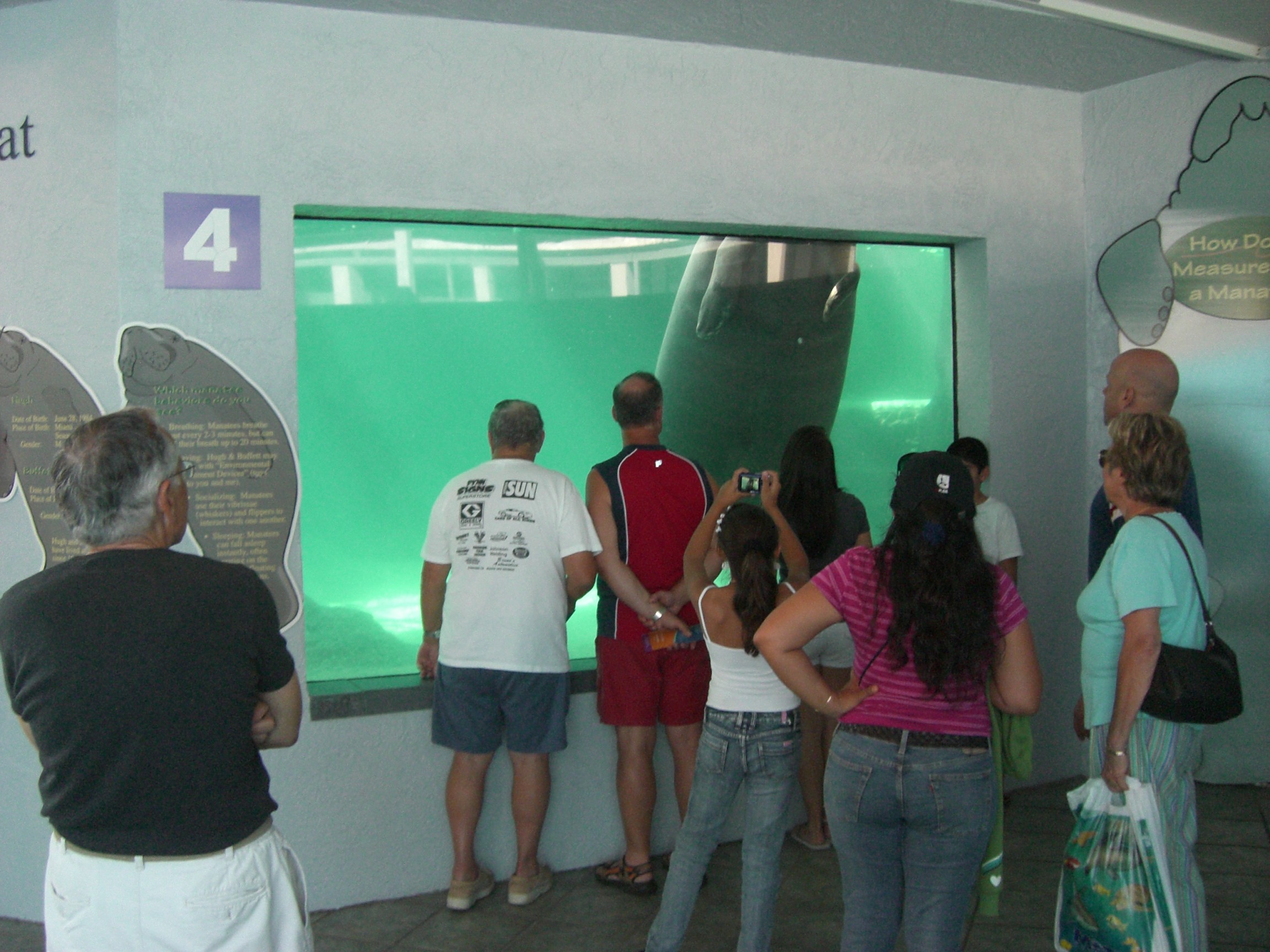
- Manatee at window
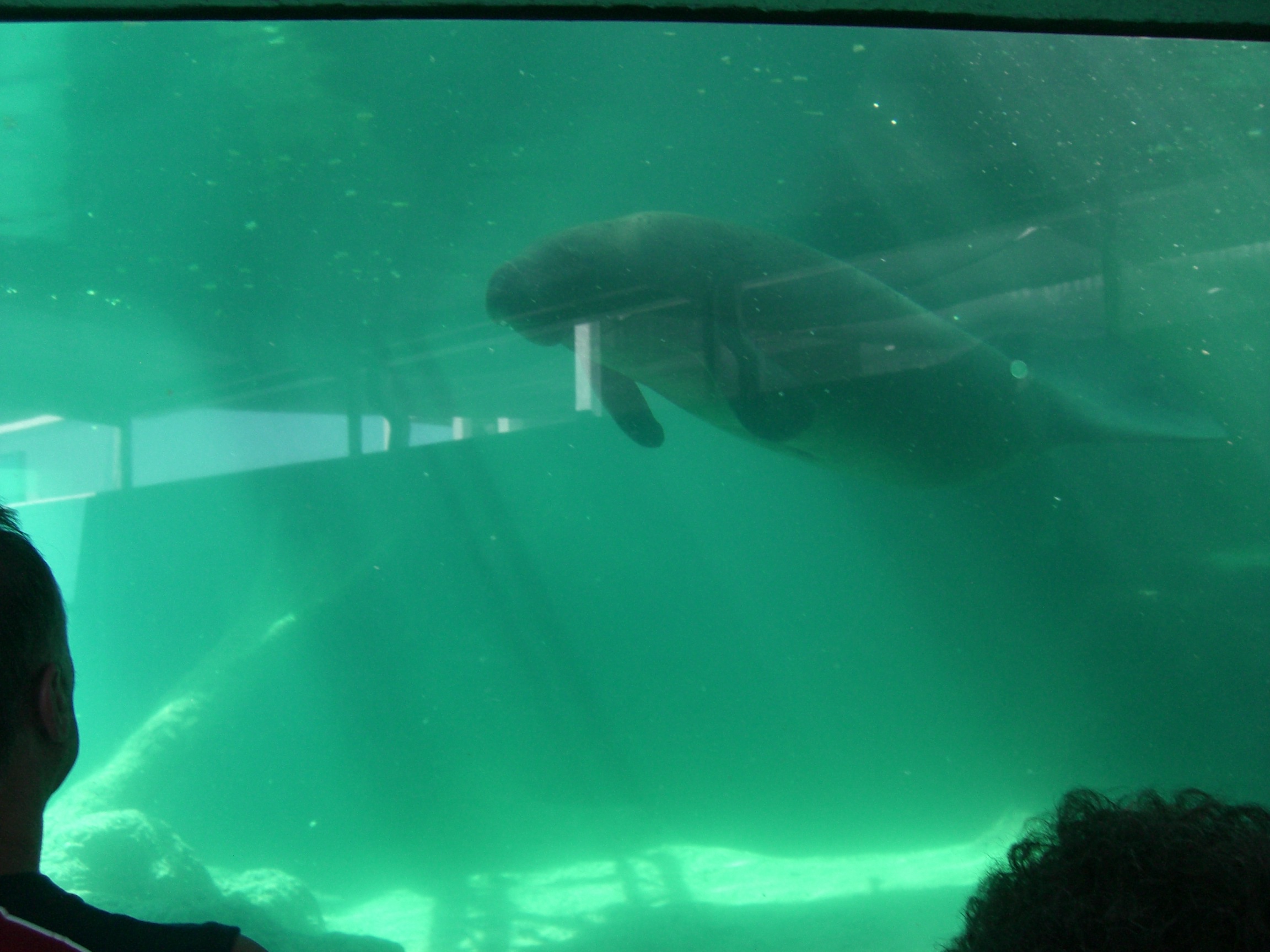
- Cloudy water and natural light equals "Is that the manatee?"
Overall, the Mote needs some help. Understanding that replacing and rebuilding exhibits is an extremely expensive process, I've put together the following Top Tips for the Mote Aquarium to increase its appeal and guest experience:
1. Clean up / Fix up!
This is the easiest and, surprisingly, sometimes, the most effective way to have immediate impact on the guest experience. Throughout the Aquarium, water quality was dank, acrylic was scratched, and signs were fading and falling apart. Take a few months and several thousands of dollars, and truly dedicate all resources to fixing and cleaning those things that are failing, or generally dingy. Fresh coats of paint in warm neutrals and soft earth tones, rather than the primaries, cool greys, and every-shade-of-blue-known-to-man currently used, would also quickly update the Aquarium into at least the year 2000.
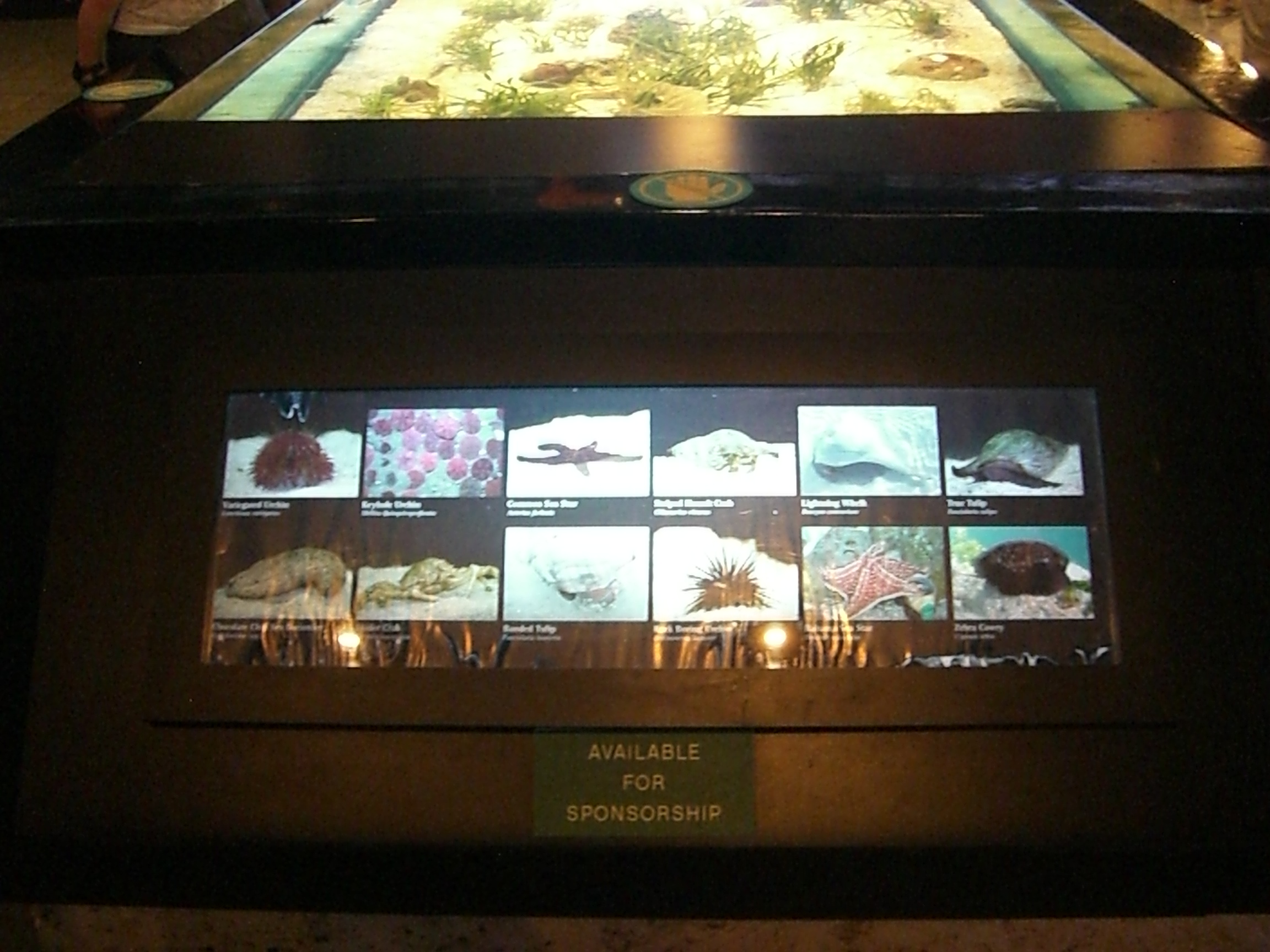
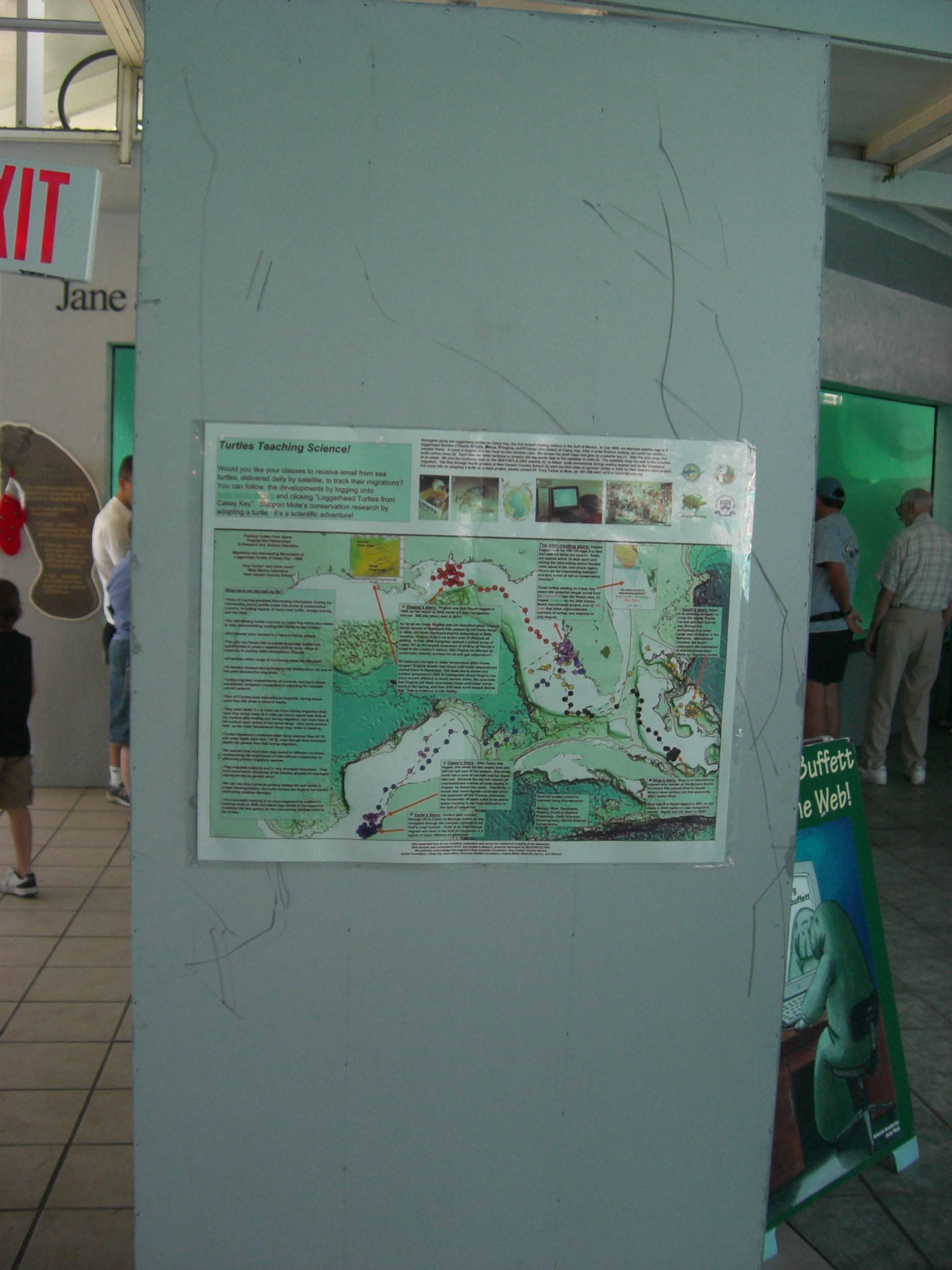
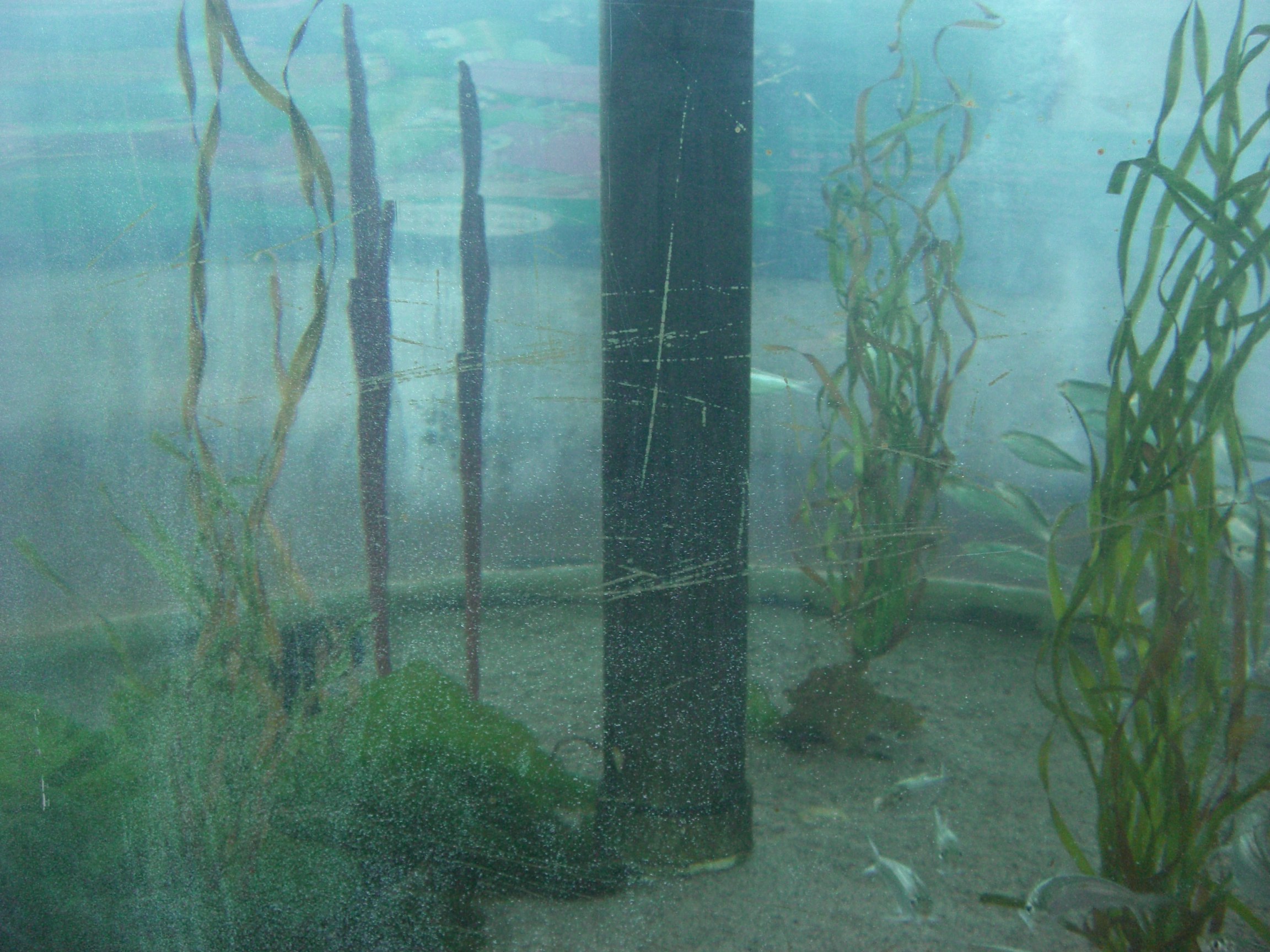
Additionally, make an effort to hide items that should be out of sight to guests, ie skimming nets, hoses, food buckets, as they were seen sitting in plain sight in several places. Buy a simple Rubbermaid closet and throw the junk in there!
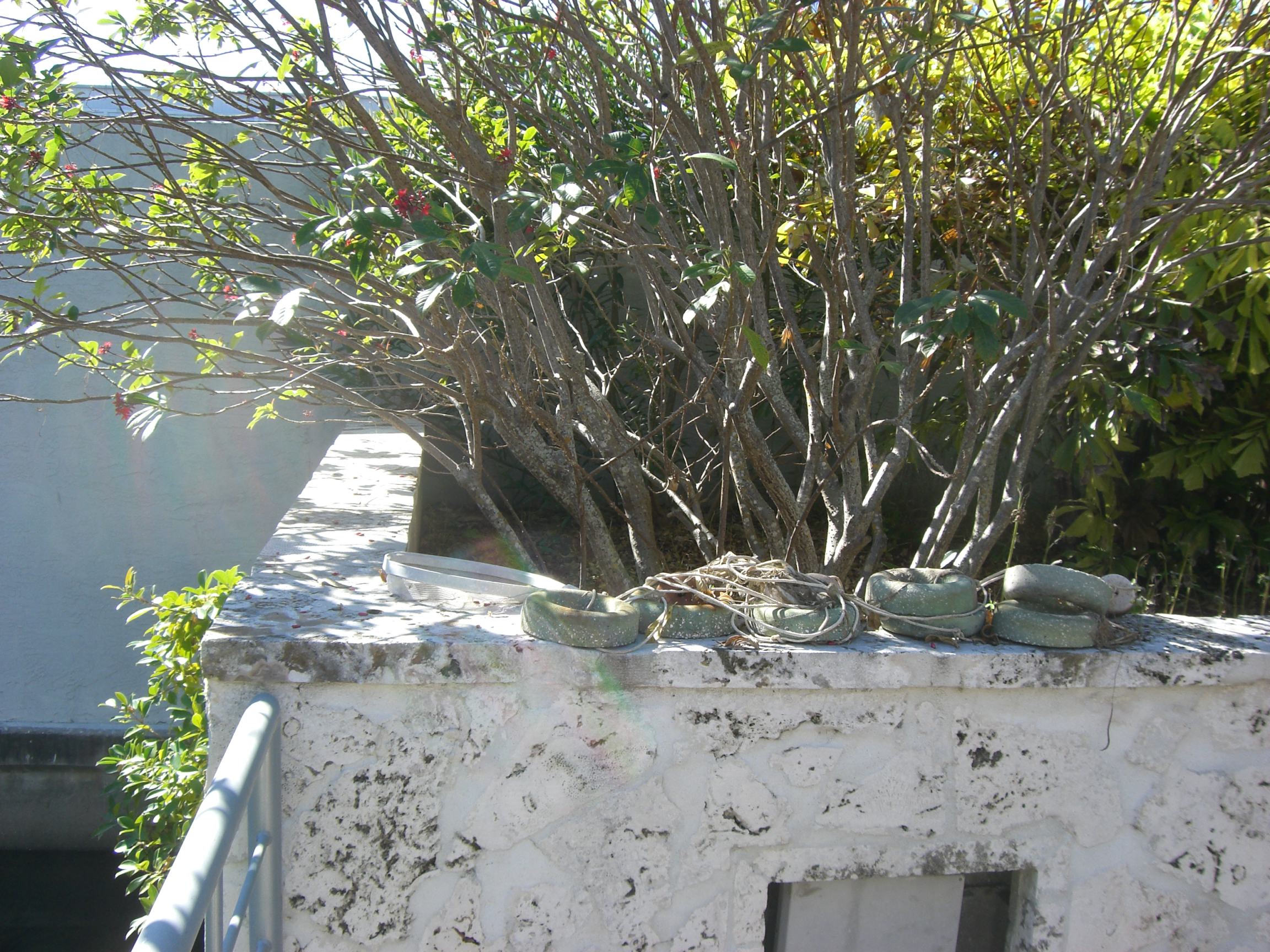
2. Invest in CLEAR Directionals
Understanding that a small aquarium generally serves a repeat customer base can mean the Mote Aquarium may be under the impression that directionals are not as needed as at, say, SeaWorld, which caters predominantly to tourists. However, without seeing their attendance demographics, I'd wager a bet that the Mote, being located where it is in Sarasota, Florida near a tourist shopping destination, is actually catering more to tourists than locals (or at least equally so). This means a large portion of the guests have never been to the Aquarium, and will, as we did, get lost and frustrated trying to locate a) the entry and b) the dolphins, sea turtles, and manatees, among other things. Mote, please, do yourself a favor...invest in signage, paving, and landscaping to help better direct your guests. And, take advantage of the walk between buildings with educational interpretives, or even just a dolphin topiary or two!
3. Invest in your possible Star Species
If you have little money, but want to increase attendance, profit or guest experience, always, always choose a star species to add / redesign / renovate. The star is marketable, even if the project is simply giving the animals a new home. Marketability means people will come, people will spend money on plush, people will tell their friends.
This may seem greedy, but what it means is an increase in revenue and hopefully profit, which means an ability to spend money on less marketable species who are really needing new homes, too.
Who am I suggesting for the Mote? Sharks! Sharks are the dangerous darlings of the sea. People love sharks; adults and kids alike are drawn to the allure of the elusive grey ghosts and respond to the element of fear instilled by the animals. Plus, renovating or adding to the dolphins doesn't make sense as they are already the Stars of the Aquarium, and guests are more than willing to make the trek to see them. Why not reward the guests for exploring the first building by elevating the sharks to Star status, then a Star species would anchor both buildings. Spend some money on this exhibit , Mote (How much you ask? Between $5 and 10 million), and I promise, you will see immediate results.
Mote Aquarium Overall Score:

Multi-Disciplinary Integration...A Mouthful of Fun!
atlantis-aquarium
It doesn't exactly roll off the tongue, but multi-disciplinary integration in tourism attractions continues to roll forward as a newly emerging trend. Discussed before purely as the evolution of 'science-based institutions', this trend is finding its way into all forms of tourism destinations.
Consider Atlantis Resort in the Bahamas and Dubai. Not only are these places over the top resorts with beautiful beaches and luxurious appointments, but they've integrated a themed water park as well as an aquatic life park into their campuses. Aquariums are found throughout the properties, and not just typical ho-hum aquariums either; we're talking Aquarium! aquariums. Much like Discovery Cove, visitors can take part in swimming with dolphins as well as enjoying other animal attractions, such as a shark tank and jellies. They've taken a resort and integrated a science-based institution. However, Atlantis is not the focus of this post.
atlantis-waterslide
Recently, in my work, we've been spending a lot of time making fun and beautiful places without stepping back to realize what it is we're really doing; without taking time to truly translate our actions into theory from which everyone in our profession can learn. That is what this post is about. Refreshing our memories about multi-disciplinary integration.
museum_of_life_l
Its happening all around us. Theme parks more seriously integrating conservation issues. Zoos incorporating science-center interactives which are about more than just the size of a polar bear's paw. Aquariums introducing land-based animal habitats. Subtle changes, yes, but all moving toward the ultimate in end goals...creating a one stop shop for science, education, AND entertainment. However, in the end, I do believe these institutions will filter out into two sects: those based on science and education (ie zoos and aquariums now), and those based on play (ie theme parks and children's museums now).
ss_brookfieldzoo-hamill
Some thoughts on what we'll see in the coming years:
Zoos (and possibly aquariums) utilizing gentle, family ride systems to introduce new ways to experience animals
More Atlantis-style resorts with focus on conservation and local habitats, including breathtaking animal habitats presented in ways not seen in zoos and aquariums
Science centers across the board becoming Life Science centers by including animal exhibits
Theme parks spending millions to incorporate Educational elements, either as stand alone attractions or as enhancements to rides and shows
jacksonville-bamboo
Jacksonville Zoo recently opened a new attraction, Asian Bamboo Garden, being touted as a 'garden' first, and 'exhibit' second. The attraction features nearly 2.5 acres of Asian gardens, with a small Komodo dragon exhibit tucked away into one corner. The Zoo focused on botanicals for this project, rather than zoological. This is rather extraordinary, if you think about it. Concept design always begins with the question: What's marketable? Projects are built to get folks through the door. Jacksonville is saying with this project, gardens are profitable. Generally, to me, zoos that call themselves 'zoos and botanical gardens' do so simply because they have beautiful grounds, not because they ever intend to add new attractions based on gardens. However, Jacksonville Zoo and Botanical Garden has done just that, truly illustrating a multi-disciplinary integration in the direction of science.
columbus-zoo-boat
And, finally, Columbus Zoo. Through a series of moves that appears to be an effort to shift almost 180 degrees from a science-based institution into a mini-resort, the Zoo has announced the initiation of a feasibility study on adding a hotel to the already massive complex. Recently, the zoo added a golf course and a water park (check out their fun website). Considering the Zoo is actually a zoo and an aquarium, the complex is quickly becoming a major multi-disciplinary destination, with the focus shifting from science to play. Columbus Zoo again illustrates the emergence of multi-disciplinary integration. I'm extremely confident that as we move forward in the evolution of science-based institutions, we'll see many, many more of these kinds of integrations.
More Elephant Controversy...
As I've posted in the past, elephants at zoos have been the target of much controversy in the recent years. Dallas Zoo recently fought public outcry to keep their lone elephant, and Chicago residents have been fighting to essentially outlaw elephants in captivity within the city limits.

Now, the Zoo has announced it will continue the exhibit construction, against dissenting opinions. It will become one of the over 60 zoos in the country to make the decision to keep their elephants, renovating their current exhibits or adding entirely new ones.
The new exhibit will be world class, promises the Zoo. At over 3 acres of animal space, it would be one of the largest in the nation. The Zoo plans on adding 3 females to make a 4 animal herd.

Now, Los Angeles joins the spotlight, as the Zoo here has decided to keep its lone bull elephant, Billy. Due to the star-studded cast of outspoken animal activists, the Zoo halted construction on the elephant's new enclosure in order to re-evaluate its plans, and to hear dissenting opinions. At the stoppage, approximately 30% of the project was complete.
Good luck to all involved in this brave project!
Take Our FAVORITE ANIMAL AT THE ZOO Poll!
Just about every time we start a new master planning project, we ask ourselves, "What are our guests' favorite animals?" Finally, we've decided to find out for ourselves. Knowing the popularity of an animal helps designers plan parks by understanding which animals will act as draws for guests through the site. It also helps the parks prioritize implementation of renovations and/or additions of new animals to take full advantage of revenue and admissions increases.
Be a part of helping plan future zoos, theme parks, and aquariums by letting us know which is your favorite animal!
[polldaddy poll=1361950]
Humboldt Penguins Get New Digs at Woodland Park Zoo
Designed by Studio Hanson Roberts, the new exhibit to open in May of this year, features green technologies and themed design. The penguins' new home will be outdoor, and features 30' of underwater viewing.
The commendable plan for the exhibit includes heating/cooling the exhibit pool through geothermal wells, and water filtration through a combination of traditional filters and Living Machine-type natural filtration. The water volume will be supplemented as needed with rainwater collected from back of house roofs.
[youtube=http://www.youtube.com/watch?v=xff3p7KjdA8&eurl=http://www.zoo.org/penguins/index.html&feature=player_embedded]
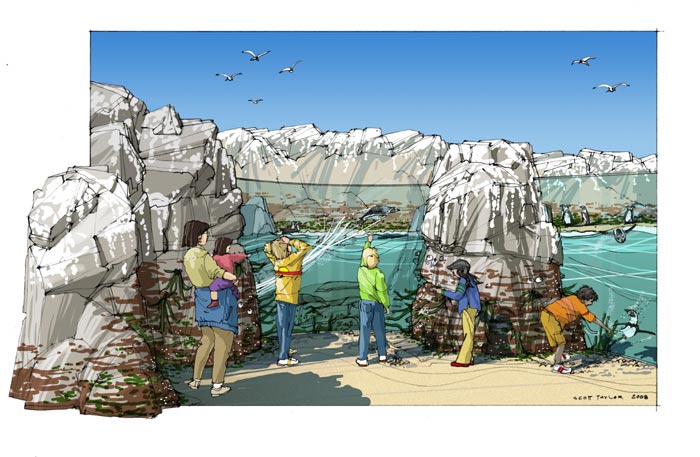
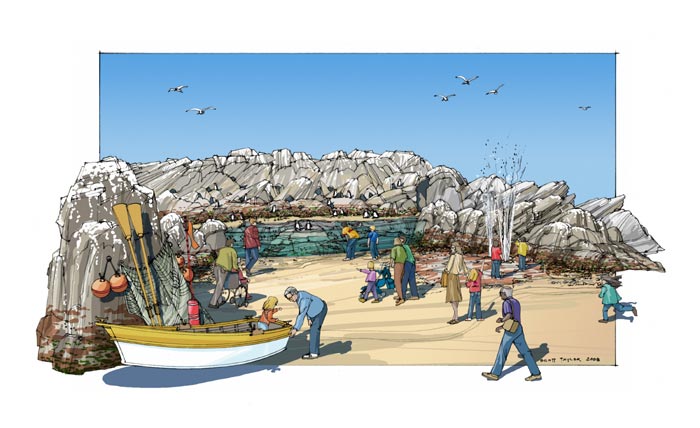
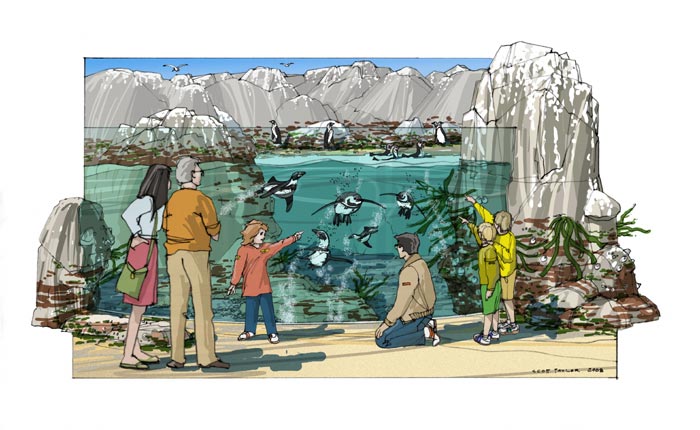
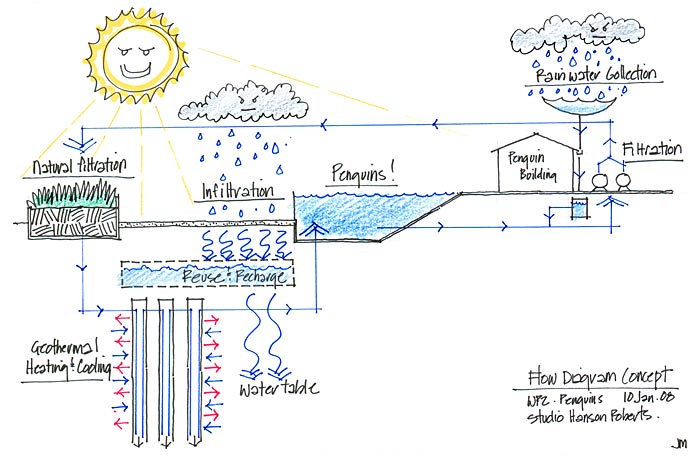
More Evidence of the Economy's Effect on Zoos
From Albuquerque, NM:
From Reuters:
"Zoos Lack Funds to Inspire Obama's Future Scientists"
From Wildlife Conservation Society, New York:
[youtube=http://www.youtube.com/watch?v=LHGuofPUnLo]
Small and Sad: Dubai Zoo's Relocation on Hold Again
Amidst the worldwide economic crisis, Dubai's exponential construction and growth has come to a screeching halt. Countless numbers of projects have been put on hold, until costcutting measures can be instated, or until the lending market (on which Dubai solely relies for its development capital) thaws.

Among these projects is the desperately bad, 5 acre Dubai Zoo. Built in the 1960s in the area referred to now as "Old Dubai", the Zoo has a long history of re-designs, master plans, and promises unkept, but this was to be the one that worked.
The city has been building to its master plan, progressing to the goal of a vast metropolitan area comparable to the world's greats. Pockets of developments can be seen across the desert; a strange world of clusters of towering skyscrapers dotting a sea of sand, connected by the widest highway you'll ever see. These pockets are the early developments of the metro's "cities", similar to NYC's burroughs. Among the cities, Sports City, Industrial City, Waterfront City, and Dubailand.
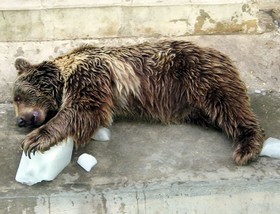
Dubailand was to be the new home for the Dubai Zoo. Dubailand, currently under construction and halted, was to be an entertainment haven, offering a variety of theme parks, malls, and, of course, the new Zoo.
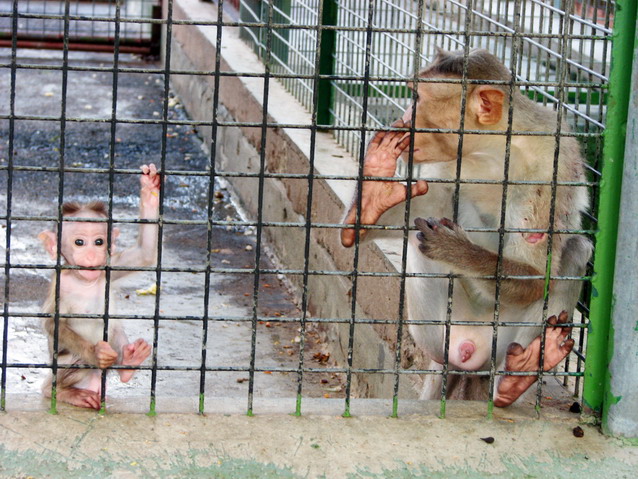
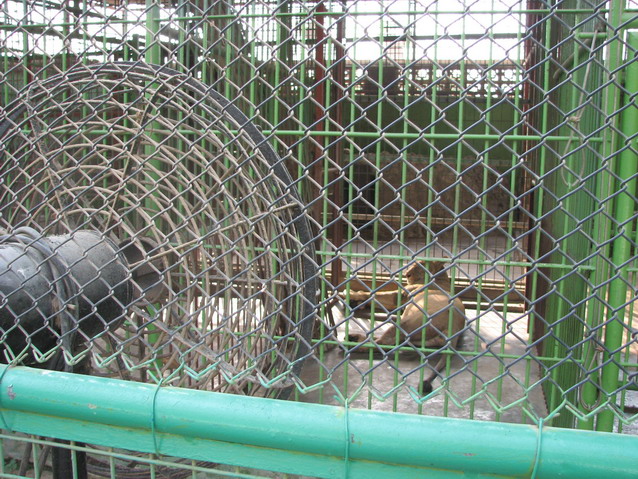
Details on the new zoo vary widely, but it appears to be approximately 200 acres and will include the zoo, a night safari, resort style accommodations, and education facilities.
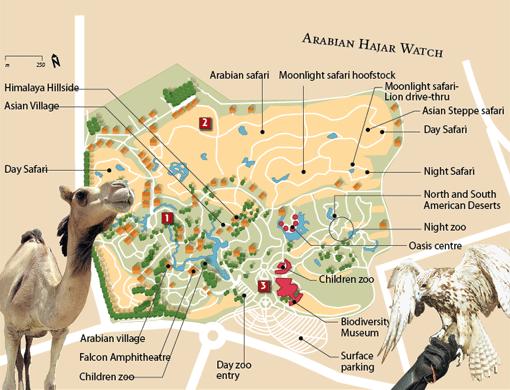
However, it remains to be seen if this relocation will actually occur, or will this just be another in a long line of unkept promises.
Read all about it here.
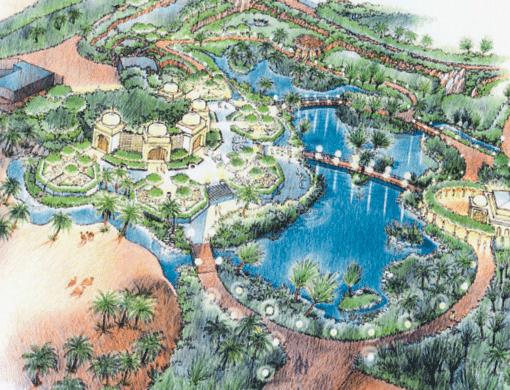
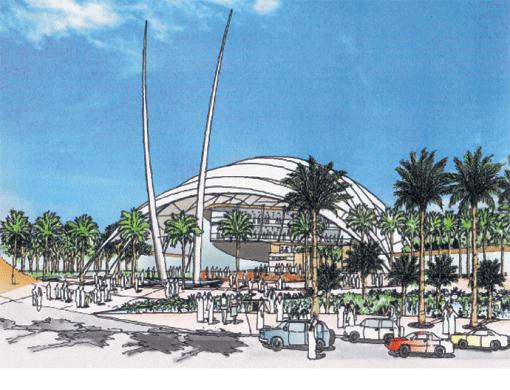
Historic Renovation to House Monkeys at KC Zoo
 Kansas City Zoo has been workly lately to give itself a face-lift. The Zoo, considered by locals to be the "red-headed step kid" to the world-famous St. Louis Zoo (a mere 3 hours' drive away), has seen less and less support in recent decades. To counter this, the Zoo has set about new construction and renovations projects throughout the facilty.
Kansas City Zoo has been workly lately to give itself a face-lift. The Zoo, considered by locals to be the "red-headed step kid" to the world-famous St. Louis Zoo (a mere 3 hours' drive away), has seen less and less support in recent decades. To counter this, the Zoo has set about new construction and renovations projects throughout the facilty.
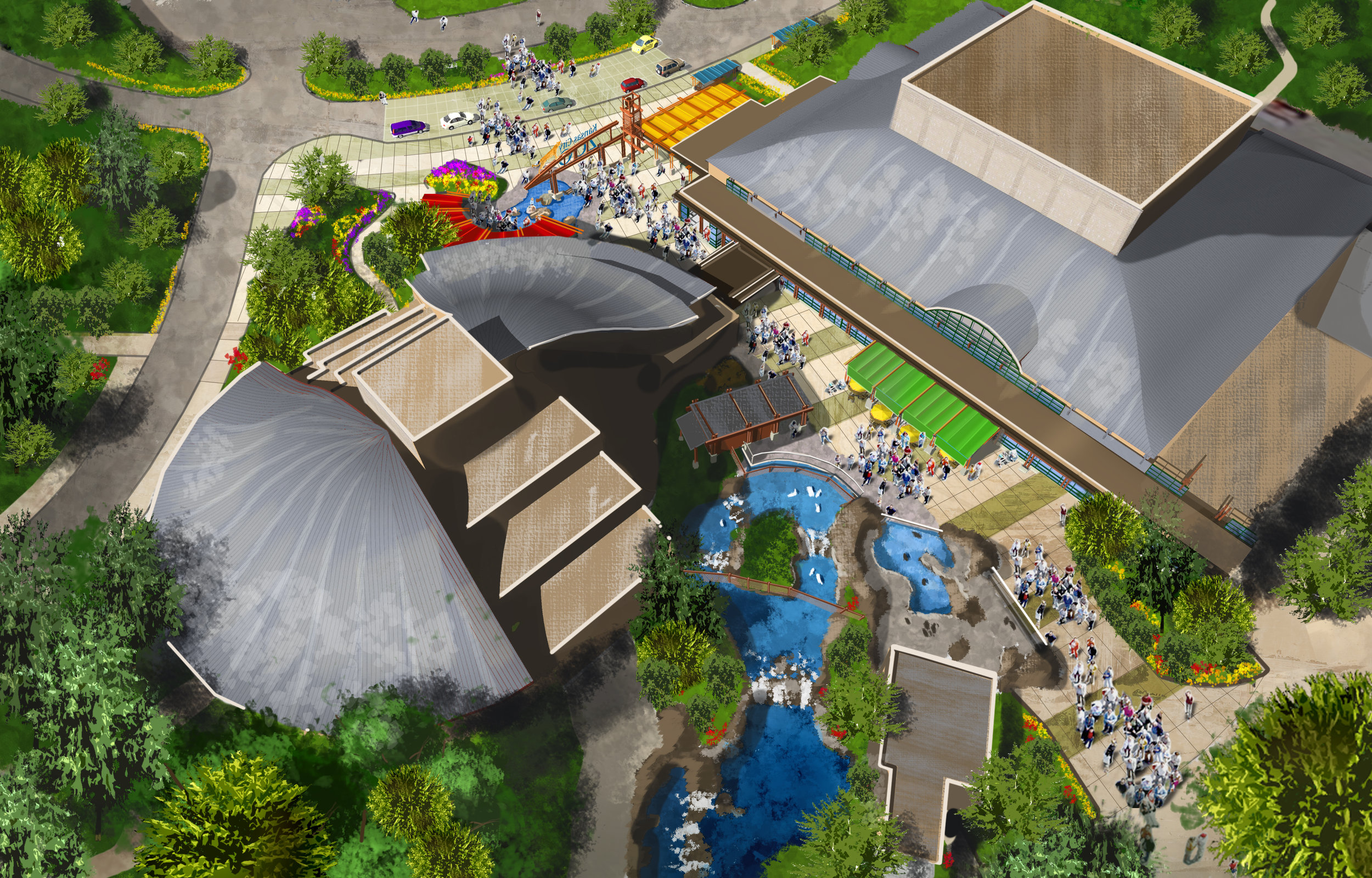
On the heels of the recently re-opened front entry plaza, including streamlined ticketing, parking, and otters as soon as you walk in, the Zoo is currently working on a renovation of its historic 1909 building. This building, which started its life as the sole animal habitat for the Zoo, has been through several iterations, most recently as an education building.

Now, however, construction is reclaiming its primary use, and inside the building a rainforest exhibit is being created. Tropical plants are being flown in from Florida to make as realistic a home as possible for the monkey species, anteaters, tropical birds, and capybara which will call this place home.
The relatively small budget of $5.1 million will allow for nearly 8000 square feet of exhibit space and 5000 square feet of support. The highlight of the exhibit is a glass enclosed bridge through the trees, where guests should be able to view monkeys playing in the branches, up close.

This exhibit is due to open in May, coinciding with the Zoo's Centennial celebration. Other upcoming plans include new homes for polar bears and penguins.
Just for Fun: St. Louis' Tigers Play in the Snow
Watch the wonderful footage here.
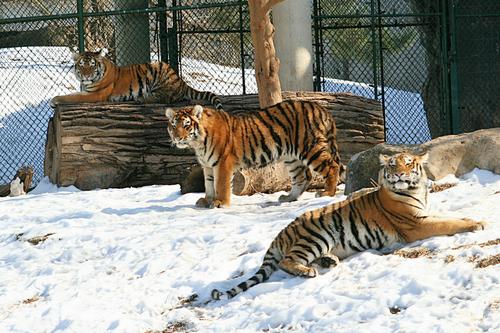
Little Rock Zoo Loses Elephant Expansion Option
Little Rock Zoo, a measly 33 acres and bounded by urban land, recently lost its most viable option for expansion when the city decided to donate an empty stadium and its lot, not to the zoo as expected, but to the hospital.
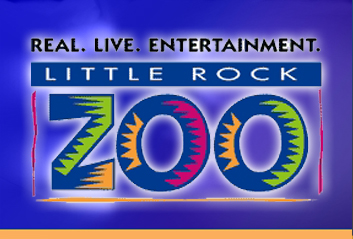
Click HERE for video coverage
Little Rock Zoo is one of the few zoos in the country keeping elephants in their collections. The land was to be used by the Zoo as an expansion to their current exhibit, in an effort to meet AZA requirements for keeping elephants.
The requirements state that institutions holding elephants must keep at least three females in a group, and are recommending institutions have the ability to be used for breeding. This means the Zoo would have to increase its size for at least one additional animal, as they currently have two females, and, if following the breeding route, would have to add space for at least one male. All of this would also include increasing the safety and security of the current exhibit to bring it up to standards for housing bull elephants. The Zoo estimated, rather loosely, that this project would cost between $10 and 20 million.
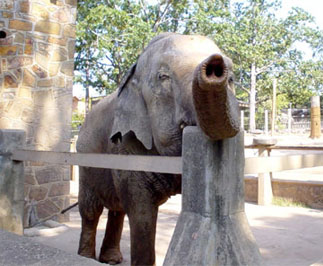
Now that the stadium land option is gone, the Zoo intends to hear additional options for expansion, which includes crossing the highway passing along its southern border. The future of the Little Rock Zoo remains to be seen, however, as pressure from the state capitol is pushing to move the zoo outside of the city proper, and the mayor is considering cutting the budget by $2 million.
Here is a very good article about the history of the zoo, and its potential future.
Chester Zoo's Answer to Bristol Zoo's EcoPark
 As pointed out in a comment on Bristol Zoo's Eco Park, Chester Zoo has just unveiled a comparative project. Very little in the way of imagery is available, but this project seems to mimic the Eden Project in its use of a bio-dome to create a simulated African rainforest.
As pointed out in a comment on Bristol Zoo's Eco Park, Chester Zoo has just unveiled a comparative project. Very little in the way of imagery is available, but this project seems to mimic the Eden Project in its use of a bio-dome to create a simulated African rainforest.
At nearly $550 million, Chester Zoo has poised itself to become the top zoo in the world for displaying African rainforest fauna. The project, encompassing approximately 200 acres (more than double the size of many city zoos, including Cincinnati, Philadelphia, and St. Louis), incorporates many theme park elements, such as a directly linked hotel and a water ride.
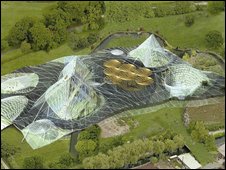
From BBC News:
"A giant dome housing a rainforest is part of a £225m plan to transform Chester Zoo into Europe's largest conservation attraction.
The project includes a 56 hectare indoor African-themed rainforest where gorillas, chimpanzees and other tropical animals can move freely.
The £90m eco dome, which would form the initial phase of the scheme, would be the first of its kind in the UK.
A 90-room hotel is also set to be part of plans submitted later this year.
The project, called Natural Vision, includes a Conservation College and a revamped main entrance linking it to a marina development on zoo land next to the Shropshire Union Canal.
The dome itself will have an interactive water ride to give visitors unique views of the animal enclosures.
 |
|
The aim is, by 2018, to showcase and support the zoo's international conservation work, which currently involves 50 countries.
Prof Gordon McGregor Reid, director general of Chester Zoo, said: "Natural Vision will offer a fun, family-friendly, adventurous, yet educational window on the world of conservation.
"New and exciting animal species will be introduced. This project is unlike anything that has been in the UK and will offer a spectacular visitor experience and the highest standards of animal welfare."
The zoo, which celebrates its 75th anniversary in May, attracts 1.3m visitors a year.
The new project is expected to see visitors rise to 2m when complete. Chester Zoo spans 50 hectares but owns another 200.
When finished, Natural Vision will cover 80 hectares including new road access and parking.
Meanwhile, hundreds of jobs will be created for the north west, during construction and following completion of the project, said a zoo spokesman.
Prof McGregor Reid added: "Our visitors will be immersed in the world of wildlife where we will engage, inform educate and amaze them in a truly thrilling and unique environment." "
I'm looking forward to getting more details and images on the plans for the expansion. Much luck to all involved!
Malaysian Aquarium Finds a Silver Lining
Many zoos and aquariums are faced with very little capital budget to do major overhauls of exhibit areas. Unfortunately, too many facilities wallow in that fact and instead of finding a creative way to keep their exhibits in top order, just allow them to falter and to, ultimately, become decripit and failing.
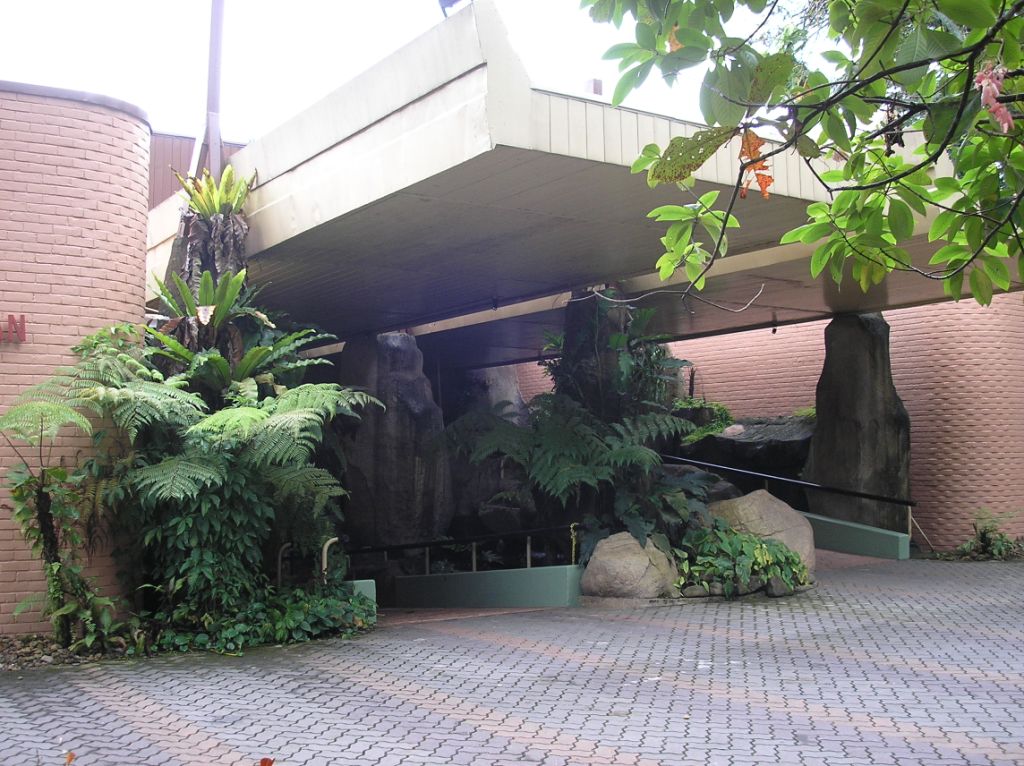
I stumbled upon this great blog post by a man known to me only as "Herman," whom apparently works in the exhibits department at a Malaysian Zoo. The Zoo had an aquarium, which they let fall into disrepair for many years, eventually leading to the Zoo closing it down. However, despite having very little money, the Zoo decided to resurrect the aquarium exhibit.
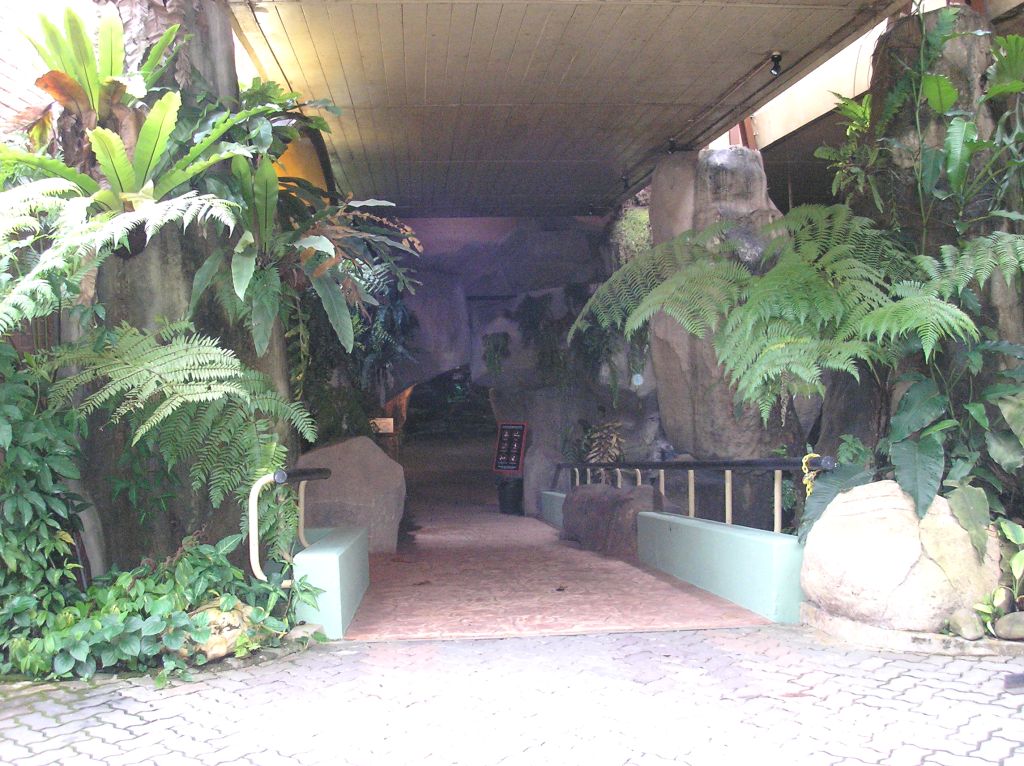
The blog outlines the small changes that made a big difference in this modest aquarium exhibit. Although not state-of-the-art nor groundbreaking, the inexpensive changes made a very big difference in the functionality and success of the exhibit, and make a wonderful example of a small budget, big impact project that I thought needed to be shared.
Take a look, here.


Correction to NY Aquarium Rendering Post
An earlier post presenting the shark exhibit concept renderings incorrectly named WRT as the exhibit designers. Seattle-based Portico Group actually developed the concept for the exhibit prior to the building shell design competition. The renderings posted earlier are the work of the Portico Group. Thanks to Charles and Rob for pointing that out.
Arizona's New Aquarium
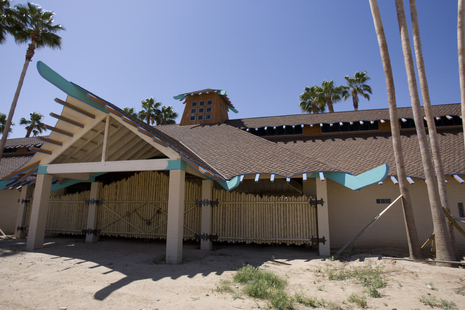
The aquarium is, in fact, the first for Arizona, but, at a mere 180,000 gallon capacity, its only a small and somewhat simple attraction by aquarium standards.

The new aquarium is an expansion of the private Wildlife World Zoo in the West Valley, and is part of a larger 10-year plan for the Zoo. This expansion cost an extremely budget-friendly $7 million.
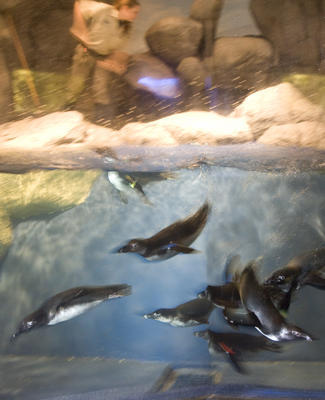
However, not to seem cynical, I must congratulate the Zoo on continuing its effort to bring education about wildlife to an area lacking quality facilities. The Zoo currently sees approximately 405,000 visitors annually, and will surely see an increase.
Exhibits at the Aquarium include what looks to be a nice black-footed penguin habitat, a small (30' diameter) shark tank, and several touch zones. The Zoo also incorporates rides into exhibits, including a log flume through one of the Aquarium's tanks, to make for a true Edutainment facility.
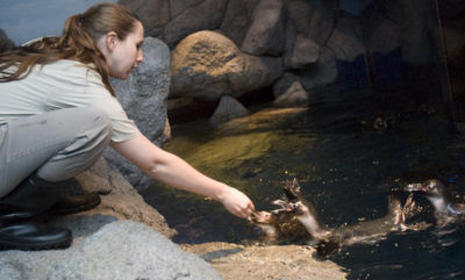
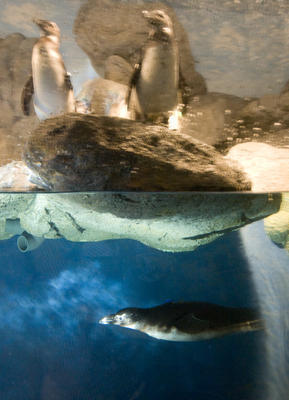
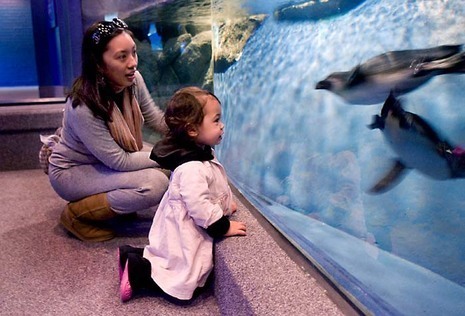
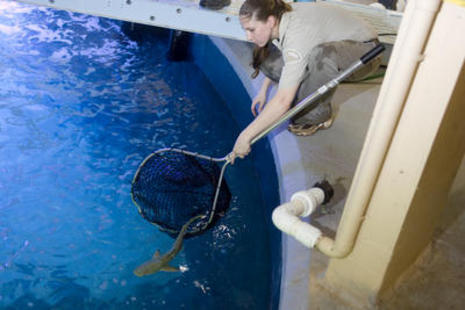
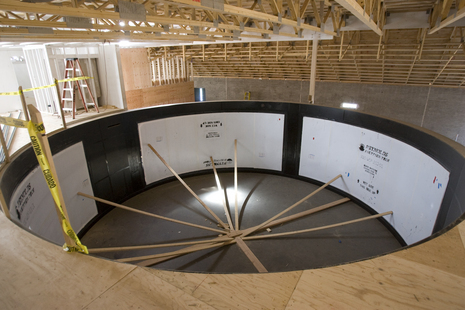
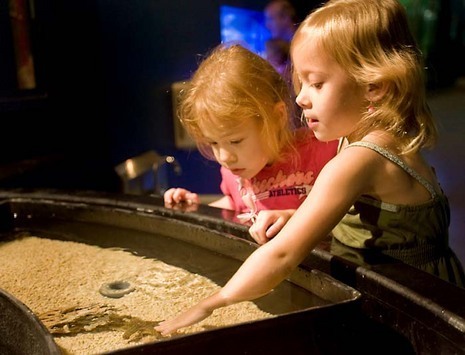
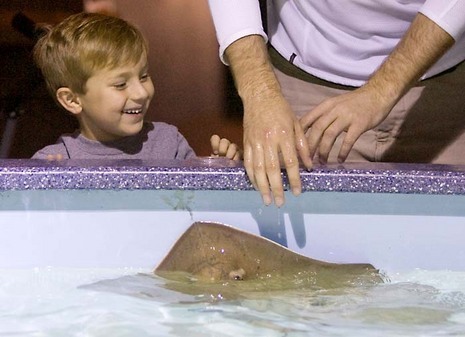
Check out the rest of the Wildlife World Zoo here.
Bristol Zoo's New Eco-Zoo
Its been touted as the "Eden Project" of wildlife.
However, if you've been to the Eden Project, you'll know this project seems to fall short. Very short, in my opinion.
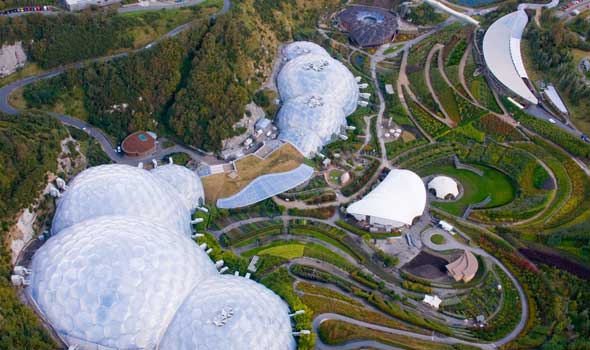
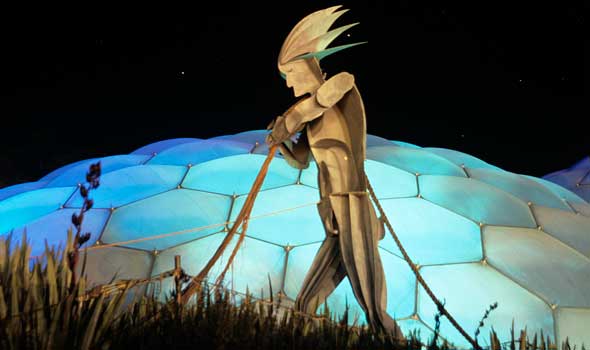 The Eden Project was, and is, as innovative in approach, as it was in design, made all that more impressive by the fact that botanical gardens and arboretia tend to be, well, on the more dull side. The Eden Project, built in a reclaimed clay mine, brought hip to gardens; it connects the reality of being green to the flashy, trendy movement. It creates a place to enjoy nature as an art, and art in nature, sometimes quite literally. It's also beautiful, fun, exciting, and a gorgeous piece of architecture and landscape architecture.
The Eden Project was, and is, as innovative in approach, as it was in design, made all that more impressive by the fact that botanical gardens and arboretia tend to be, well, on the more dull side. The Eden Project, built in a reclaimed clay mine, brought hip to gardens; it connects the reality of being green to the flashy, trendy movement. It creates a place to enjoy nature as an art, and art in nature, sometimes quite literally. It's also beautiful, fun, exciting, and a gorgeous piece of architecture and landscape architecture.
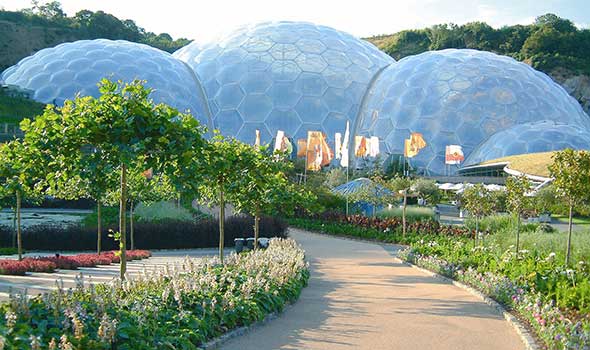
Bristol Zoo's "Eco-Zoo", which was conceived over 40 years ago and since shelved, claims to become "the first conservation-led animal visitor attraction of its kind in the UK." The $140 million Park is planned at 136 acres, and aims to be open by 2012, a lofty goal considering it hasn't yet been approved. The Park estimates attendance at 400,000 annually.
Touting itself as the "next generation of zoological attractions", I'm especially curious at what it aims to do differently. The single article I could find about it outlines a few key points:
1. "Bristol's "eco zoo" could connect the inherent interest value of captive animals with the conservation methods needed to save their wild cousins."
2. "The whole idea of captivity will be reduced to a minimum....The often controversially cramped spaces of the Victorian era's most famous zoos are gone – replaced with open land, moats and ditches."
3. "...most importantly, the four themed areas of the park...have all been chosen to reflect specific areas of the world where conservation is desperately needed to save critically endangered species. "


So far, this sounds very similar to most zoos creating new exhibits across the U.S. and world. Victorian era design died in the Victorian era, and as illustrated in a previous post, the idea of landscape immersion has been around since the 1970s. Creating themed areas based on conservation needs is what is done with virtually every new exhibit out there. What of all of the recent and upcoming Arctic exhibits? Bronx Zoo's Madagascar!? I'm duly unimpressed thus far...
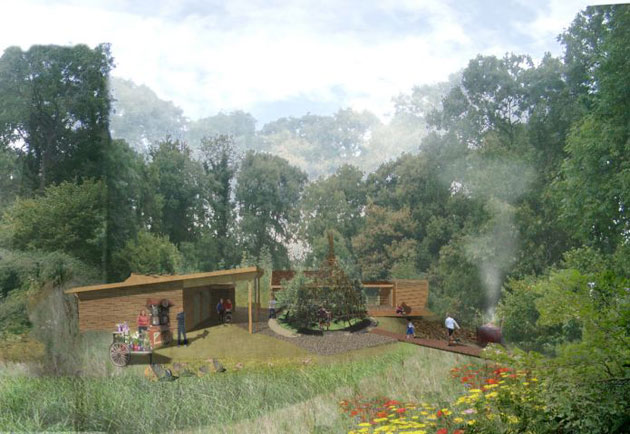
- The Eco-Zoo's British Woodland Exhibit

But then there's this:
"Food for the animals will be organic, while 80 per cent of the building material will be locally sourced and sustainable. "
And this:
"Every aspect of the park's design incorporates sustainability, from the buildings and the engineering infrastructure to the landscape."
Now that's new. Seriously, folks. Zoos tout themselves as conservation leaders, but are some of the most un-green institutions out there. Tremendous amounts of water and electricity are wasted daily on washout of stalls and sustaining water life support systems in tanks and pools, amongst other things.
Buildings themselves are most often behind the scenes and often suffer from the smallest budget. For this reason, environmentally friendly alternative building practices rarely are integrated. Recently, however, some zoos have been making an effort with their "non-animal" buildings, such as the LEED silver certified Nutrition Center at St. Louis Zoo.
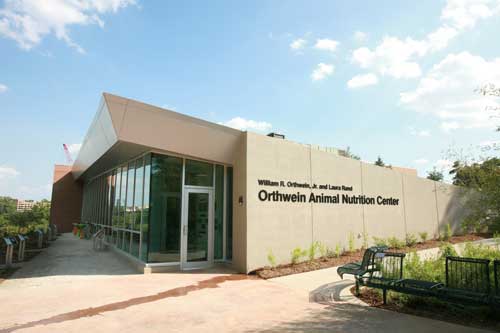
Speaking of the infamous LEED (Leadership in Energy and Environmental Design) Accreditation, no standards exist for buildings housing animals. So, zoos and aquariums looking to do right by the environment through LEED (and gain a little good press and grant money, too), are oftentimes without means. In the non-profit sector (as in many others), if you can't gain revenue or attendance increases from something, it isn't done. And there goes the green leadership...
However, if this project can put their money where their mouth is (almost literally!), they may be onto something special. If not for innovation in zoological exhibit design, then definitely for innovation in zoological construction and green design.
I'll be keeping my eyes peeled for more news about this potentially exciting project.
Chiang Mai Zoo's Aquarium Open At Last...
 The Aquarium, the newest add to Thailand's Chiang Mai Zoo, is finally open. In late October, the Aquarium shut down literally hours after its official opening gala, due to malfunctions in both the life support systems and the ticketing machines.
Apparently, sand had found its way past the filtration system entering the main tank, and creating water murky enough to delay the opening for about three weeks.
The Aquarium, the newest add to Thailand's Chiang Mai Zoo, is finally open. In late October, the Aquarium shut down literally hours after its official opening gala, due to malfunctions in both the life support systems and the ticketing machines.
Apparently, sand had found its way past the filtration system entering the main tank, and creating water murky enough to delay the opening for about three weeks.

However, the Aquarium is now up and running, and is touted as Southeast Asia's largest with an expectation to gain 800,000 visitors annually. The Aquarium was built as a joint venture between the Zoological Park Organization (an apparently governmental body) and an undisclosed private investor for the sum of $17 million.
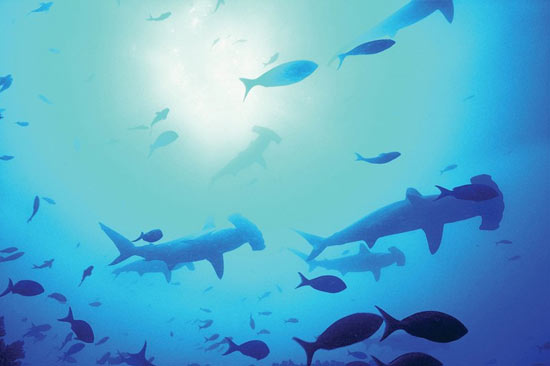
Boasting the World's Longest Acrylic Tunnel at 133 meters (436 feet--longer than a football field!), the Aquarium is over 13,000 sf in area divided into 9 zones. The tunnel itself not only allows visitors to gaze into the depths of a marine environment, but also takes visitors through a freshwater tank.
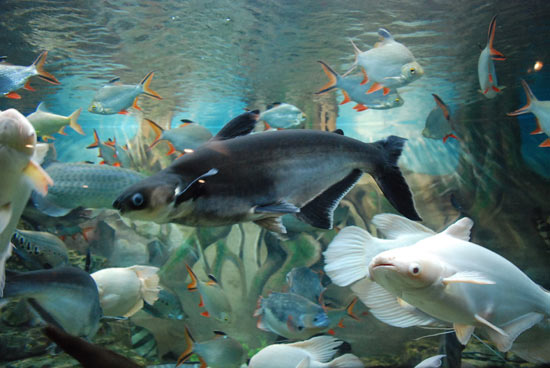
I've not been able to find many pictures of the Aquarium online, so if you know of any, please let me know.
Dubai's Record Setting Acrylic
 Recently opened Dubai Aquarium, inside the gargantuan Dubai Mall, set the new Guiness World Record for "World's Largest Acrylic Panel" this November.
According to Emaar Malls, the Dubai Mall developer, the panel measures "32.88 metres wide x 8.3 metres high x 750 mm thick...weighing 245,614 kg, the viewing panel at Dubai Aquarium surpasses the current Guinness World Record holder, Churaumi Aquarium in Okinawa, Japan, at 22.5 metres wide x 8.2 metres high and 600 mm thick."
Recently opened Dubai Aquarium, inside the gargantuan Dubai Mall, set the new Guiness World Record for "World's Largest Acrylic Panel" this November.
According to Emaar Malls, the Dubai Mall developer, the panel measures "32.88 metres wide x 8.3 metres high x 750 mm thick...weighing 245,614 kg, the viewing panel at Dubai Aquarium surpasses the current Guinness World Record holder, Churaumi Aquarium in Okinawa, Japan, at 22.5 metres wide x 8.2 metres high and 600 mm thick."
For those metric-impared Americans, that's nearly 108' wide x 27' tall. This dwarfs the large and impressive Ocean Voyager acrylic panel at Georgia Aquarium, which is 61' wide x 23' tall.
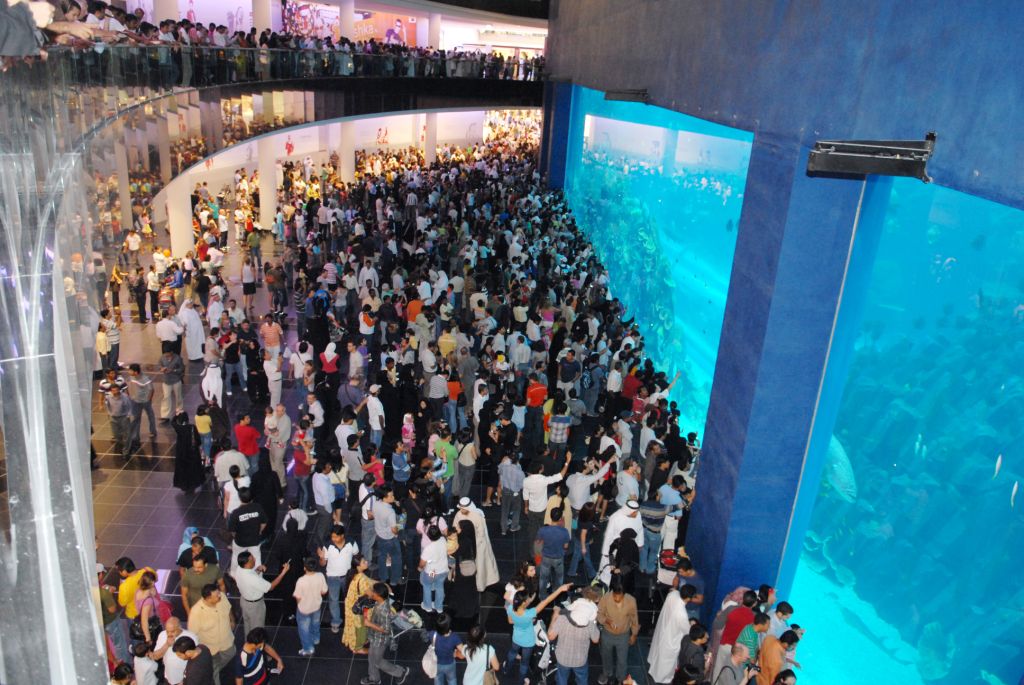
The large tank also has a long tunnel, running about 160' in length at a depth of 36'. Georgia Aquarium's tunnel is only 100' in length at a similar depth. However, both of these tunnels are tiny compared to L'Aquarium in Barcelona, Spain. This tunnel is reportedly over 260' in length!
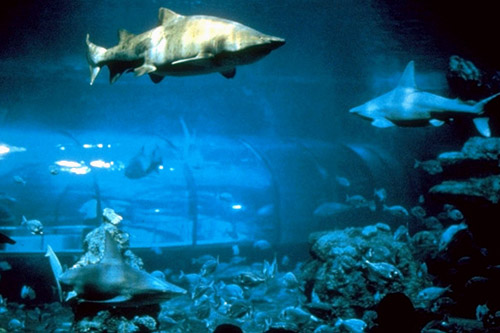
The rest of the Dubai Aquarium includes three habitat centered thematic zones: Living Ocean (different from the large ocean tank), Rocky Shore, and Rainforest.
Living Ocean highlights unusual individual specimens such as Moray Eels, Jellies, and Sea Dragons. The Rocky Shore showcases Humboldt penguins, Harbour seals, and a touch tidal pool. The Rainforest focuses on interesting freshwater creatures like piranha, catfish, and otters.










































